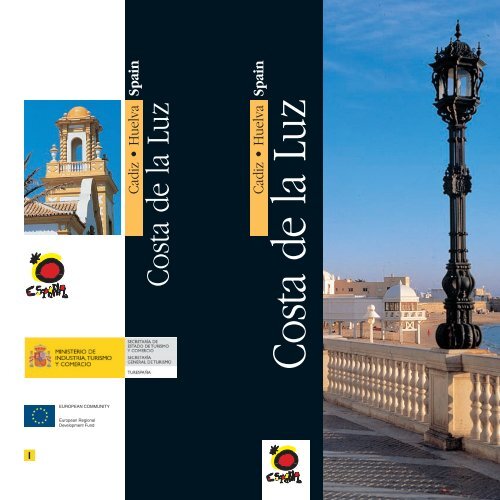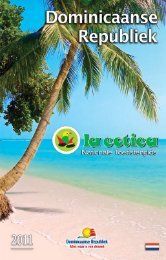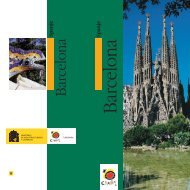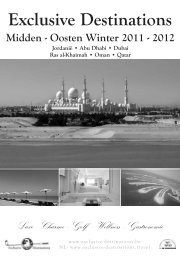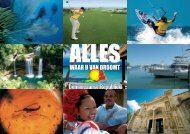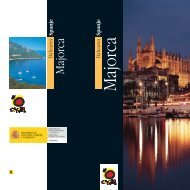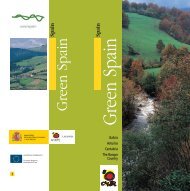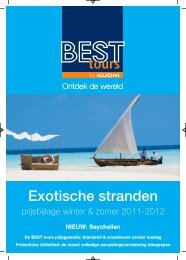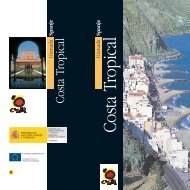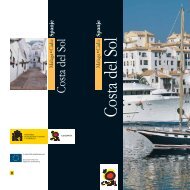You also want an ePaper? Increase the reach of your titles
YUMPU automatically turns print PDFs into web optimized ePapers that Google loves.
Cadiz • Huelva<br />
<strong>Costa</strong> <strong>de</strong> <strong>la</strong> <strong>Luz</strong><br />
Spain<br />
Cadiz • Huelva<br />
<strong>Costa</strong> <strong>de</strong> <strong>la</strong> <strong>Luz</strong><br />
Spain<br />
EUROPEAN COMMUNITY<br />
European Regional<br />
Development Fund<br />
I
C O N T E N T S<br />
Introduction 1<br />
Coastal routes 2<br />
The domains of Guzmán el Bueno 2<br />
Cadiz: “La Tacita <strong>de</strong> P<strong>la</strong>ta” 6<br />
Jerez and the Sherry Triangle 10<br />
Coto <strong>de</strong> Doñana and the Romería<br />
of El Rocío 16<br />
The Port of the Three Caravels 18<br />
From Punta Umbría to Ayamonte 24<br />
In<strong>la</strong>nd routes 26<br />
The route of the ventas and<br />
the bulls 26<br />
The white towns 27<br />
Nieb<strong>la</strong> and the wines of El Condado 29<br />
The Sierra <strong>de</strong> Aracena 30<br />
Sierra Minera 33<br />
Leisure and entertainment 34<br />
Useful information 36<br />
Portugal<br />
Ire<strong>la</strong>nd<br />
Dublin<br />
Cantabrian Sea<br />
Madrid<br />
United<br />
Kingdom<br />
London<br />
Paris<br />
France<br />
Introduction<br />
Apart from a few rocky stretches, the <strong>Costa</strong> <strong>de</strong> <strong>la</strong> <strong>Luz</strong> is a<br />
continuous line of fine sandy beaches backed by pine groves.<br />
F<strong>la</strong>nked by saline and marsh, the lower reaches of the rivers<br />
present a scene that has barely changed in centuries.<br />
The name <strong>Costa</strong> <strong>de</strong> <strong>la</strong> <strong>Luz</strong>, or Coast of Light, comes from<br />
the way the sea reflects the sunlight like a mirror.<br />
This coastline preserves many remin<strong>de</strong>rs of ancient history.<br />
Here was the kingdom of Tartessos, where Phoenician and<br />
Greek tra<strong>de</strong>rs <strong>la</strong>n<strong>de</strong>d. Later came the Romans, followed in<br />
the 8 th century by the Arabs, who stayed for another eight<br />
centuries. This was also the jumping-off point for the most<br />
famous sea voyage in all history, which brought Christopher<br />
Columbus and his three carvels to the shores of America.<br />
In<strong>la</strong>nd is olive-draped hill country and two of the loveliest<br />
mountain areas in Spain - the Sierra <strong>de</strong> los Pueblos B<strong>la</strong>ncos in<br />
Cadiz and the Sierra <strong>de</strong> Aracena in Huelva, in both of which<br />
the vil<strong>la</strong>ges stand out white against the <strong>la</strong>ndscape.<br />
Lisbon<br />
SPAIN<br />
Caños <strong>de</strong> Meca. Cadiz<br />
At<strong>la</strong>ntic Ocean<br />
Huelva<br />
<strong>Costa</strong> <strong>de</strong> <strong>la</strong> <strong>Luz</strong><br />
Cadiz<br />
Ceuta<br />
Mediterranean<br />
Sea<br />
Text:<br />
César Justel<br />
Trans<strong>la</strong>tion:<br />
Alister L. Ross<br />
Photographs:<br />
Archives Turespaña<br />
Design:<br />
P&L MARÍN<br />
Melil<strong>la</strong><br />
Published by:<br />
© Turespaña<br />
Secretaría <strong>de</strong> Estado<br />
<strong>de</strong> Turismo y Comercio<br />
Ministerio <strong>de</strong> Industria,<br />
Turismo y Comercio<br />
Printed by:<br />
Gaez, S.A.<br />
D.L.: M-23.641-2004<br />
NIPO: 380-04-009-7<br />
Printed in Spain<br />
3 nd Edition<br />
1
Coastal<br />
routes<br />
The domains of<br />
Guzmán el Bueno<br />
For nearly eight centuries<br />
this part of the Coast lived<br />
through alternating periods of<br />
peaceful coexistence and<br />
warfare between Arab and<br />
Christian. Perhaps the image<br />
that best encapsu<strong>la</strong>tes the<br />
confrontations between<br />
the two cultures is that of a<br />
knight who hurls a dagger<br />
from the battlements and<br />
enjoins the Arabs to s<strong>la</strong>y his<br />
son with it. The knight<br />
concerned is known to history<br />
as Guzman el Bueno and the<br />
episo<strong>de</strong> occurred at the<br />
fortress of Tarifa, which still<br />
stands (albeit very much<br />
altered) along with the<br />
original city walls. Within is<br />
the church of Santa María,<br />
built upon the remains of a<br />
mosque. The ancient fortress<br />
and the small peninsu<strong>la</strong> of<br />
Punta Tarifa provi<strong>de</strong> fine<br />
vantage points from which to<br />
view the coast of Africa.<br />
Thanks to the west and east<br />
winds, Tarifa today is a<br />
paradise for windsurfing (it is<br />
the venue for international<br />
windsurfing championships)<br />
and acqualung fishing. There<br />
are three beaches: Bolonia<br />
(6 km), Los Lances (10 km) and<br />
La P<strong>la</strong>ta (4 km).<br />
In<strong>la</strong>nd from the stretch of<br />
At<strong>la</strong>ntic coast between Tarifa<br />
and Cadiz are numerous<br />
ranges where fighting bulls<br />
are raised. Fourteen<br />
kilometres from Tarifa a road<br />
leads off to the Ensenada <strong>de</strong><br />
Bolonia. Here lie the ruins of<br />
the Roman town of Baelo<br />
C<strong>la</strong>udia, now a museum, and a<br />
vast extent of white, sandy<br />
beach.<br />
Beach. Tarifa<br />
DE DOÑANA<br />
Trebujena<br />
Sanlúcar<br />
<strong>de</strong> Barrameda<br />
Chipiona<br />
Rota<br />
El Puerto <strong>de</strong><br />
Santa María<br />
CÁDIZ<br />
Lebrija<br />
IV<br />
San Fernando<br />
Chic<strong>la</strong>na<br />
Sancti-Petri<br />
Puerto Real<br />
A-4<br />
Arcos <strong>de</strong><br />
<strong>la</strong> Frontera<br />
Jerez<br />
<strong>de</strong> <strong>la</strong> Frontera<br />
PARQUE NATURAL<br />
DE LA BAHÍA DE CÁDIZ<br />
Medina<br />
Sidonia<br />
Puerto Serrano<br />
Vil<strong>la</strong>martín<br />
Algodonales<br />
Bornos<br />
Prado<br />
<strong>de</strong>l Rey<br />
Alcalá <strong>de</strong><br />
los Gazules Jimena<br />
<strong>de</strong> <strong>la</strong> Frontera<br />
Conil <strong>de</strong><br />
Vejer<br />
<strong>la</strong> Frontera <strong>de</strong> <strong>la</strong> Frontera Los Barrios<br />
PARQUE NATURAL BREÑA<br />
Y MARISMAS DE BARBATE<br />
340 PARQUE NATURAL<br />
DE LOS<br />
Cabo <strong>de</strong> Trafalgar Barbate ALCORNOCALES<br />
Zahara <strong>de</strong><br />
los Atunes<br />
Algeciras<br />
Ensenada <strong>de</strong> Bolonia<br />
Punta Camarinal<br />
Tarifa<br />
Punta <strong>de</strong> Tarifa<br />
Also on this stretch of the<br />
coast is Zahara <strong>de</strong> los Atunes,<br />
a fishing town of long<br />
tradition where bungalows<br />
and resi<strong>de</strong>ntial estates have<br />
sprung up in recent years.<br />
In spring and <strong>la</strong>te summer<br />
visitors to Zahara can still<br />
witness the time-honoured<br />
spectacle of tuna fishing from<br />
the shore with nets.<br />
Olvera<br />
Ronda<br />
Estepona<br />
340<br />
Ten kilometres further on is<br />
Barbate, site of the famous<br />
Caños <strong>de</strong> Meca, an area of<br />
exceptional beauty with<br />
natural springs and numerous<br />
pine groves crowding almost<br />
to the sea’s edge. Hard by is<br />
Cape Trafalgar, whose<br />
lighthouse stands as a<br />
remin<strong>de</strong>r of the famous battle<br />
Baelo C<strong>la</strong>udia. Bolonia<br />
2<br />
3
where Admiral Nelson fell at<br />
the moment of victory, along<br />
with the Spanish mariners<br />
Gravina and Churruca. The<br />
cape is boun<strong>de</strong>d on either si<strong>de</strong><br />
by semi-virgin beaches of<br />
near-white sand.<br />
Only ten kilometres in<strong>la</strong>nd<br />
Vejer <strong>de</strong> <strong>la</strong> Frontera rears up<br />
like a watchtower, reputedly<br />
one of the most Arab (and<br />
loveliest) towns in the entire<br />
province of Cadiz. Particu<strong>la</strong>rly<br />
outstanding are the church of<br />
El Salvador, the Arco <strong>de</strong> <strong>la</strong>s<br />
Vejer <strong>de</strong> <strong>la</strong> Frontera<br />
Zahara <strong>de</strong> los Atunes<br />
Monjas (Arch of the Nuns),<br />
the noble houses and the<br />
remains of the mediaeval<br />
<strong>de</strong>fence works.<br />
The next municipality along<br />
the coast is Conil <strong>de</strong> <strong>la</strong><br />
Frontera, a fishing town which<br />
has attracted a lot of tourism<br />
in recent years, located as it is<br />
near two immense beaches.<br />
From Conil the road runs<br />
on to Chic<strong>la</strong>na, an industrial<br />
town on the fringe of the<br />
marsh<strong>la</strong>nd that surrounds<br />
the Bay of Cadiz.<br />
Fontanil<strong>la</strong> Beach.<br />
Conil <strong>de</strong> <strong>la</strong> Frontera<br />
The old town disp<strong>la</strong>ys white<br />
house-fronts broken by <strong>la</strong>rge<br />
windows with wrought-iron<br />
bars. Nearby is La Barrosa<br />
beach, one of the best-known<br />
on the entire coast, and the<br />
abandoned hamlet of Sancti<br />
Petri. On an is<strong>la</strong>nd there, also<br />
called Sancti Petri, stands a<br />
castle built on what was once<br />
a Phoenician sanctuary, <strong>la</strong>ter<br />
<strong>de</strong>dicated to Hercules by the<br />
Romans.<br />
The <strong>la</strong>st stop before reaching<br />
the provincial capital<br />
is San Fernando,<br />
a town closely<br />
tied to the naval battles of<br />
the Napoleonic wars. San<br />
Fernando boasts a number of<br />
monuments, chief among<br />
them the twin-towered parish<br />
church and the castle of San<br />
Romualdo. The buildings are<br />
of whitewashed brick with<br />
stone doorways and urn<strong>de</strong>corated<br />
terraces – one of<br />
the finest examples<br />
of Baroque<br />
architecture in<br />
the province<br />
of Cadiz.<br />
Church of<br />
La Inmacu<strong>la</strong>da.<br />
Barbate<br />
4
Cadiz:<br />
“La Tacita <strong>de</strong> P<strong>la</strong>ta”<br />
In Cadiz the sea is the<br />
beginning and the end of<br />
everything – “salt-glittering”<br />
was the term used by the poet<br />
Manuel Machado. A seafaring<br />
city always (foun<strong>de</strong>d by<br />
Hercules himself according to<br />
legend) Cadiz c<strong>la</strong>ims to be the<br />
ol<strong>de</strong>st city in the West. If<br />
possible, visitors should try to<br />
approach the city by sea,<br />
crossing the bay on one of<br />
the boats (known locally as<br />
vaporcitos, or little steamers)<br />
that shuttle between Cadiz<br />
and El Puerto <strong>de</strong> Santa María<br />
on the far si<strong>de</strong> of the bay, a<br />
crossing of about one hour.<br />
Those who do will un<strong>de</strong>rstand<br />
why Cadiz is popu<strong>la</strong>rly<br />
known as La Tacita <strong>de</strong> P<strong>la</strong>ta<br />
(the Silver Cup).<br />
The new part of the city,<br />
recognisable by the<br />
mo<strong>de</strong>rn buildings,<br />
f<strong>la</strong>nks a long avenue<br />
which is the only<br />
means of access for those<br />
arriving by car. The Puerta <strong>de</strong><br />
Tierra, or Land Gate – a piece<br />
of 17 th -century fortification –<br />
separates the old town from<br />
the new. The best way to start<br />
is by taking a stroll through<br />
the Barrio <strong>de</strong>l Pópulo, the<br />
most authentic part of the old<br />
Cadiz, which huddles around<br />
the Cathedral – a <strong>la</strong>rge<br />
Baroque building with a bluetiled<br />
dome. Not far from there<br />
is the church of Santa Cruz,<br />
the first p<strong>la</strong>ce of Christian<br />
worship in Cadiz foun<strong>de</strong>d by<br />
King Alfonso X the Wise on<br />
the site of an Arab mosque.<br />
The many churches inclu<strong>de</strong><br />
Santo Domingo (which has a<br />
marble-columned cloister),<br />
Santa María, Santiago,<br />
San Agustín, San Francisco<br />
(containing works by<br />
Montañés), San Antonio,<br />
P<strong>la</strong>za <strong>de</strong> San Juan <strong>de</strong> Dios.<br />
Cadiz<br />
El Carmen and El Rosario<br />
(which houses sculptures of<br />
the city’s patron saints San<br />
Servando and San Germán).<br />
Also worth seeing are the<br />
old Cigar Factory, the Royal<br />
Prison, the Provincial Museum,<br />
the Santa Cueva or Holy Cave<br />
(with frescoes by Goya), the<br />
Town Hall, the Gran Teatro<br />
Fal<strong>la</strong>, Torre Tavira and<br />
Castle of San Sebastián. Cadiz<br />
Paseo Campo <strong>de</strong>l Sur. Cadiz<br />
the Oratory of San Felipe Neri,<br />
where Spain’s first<br />
Constitution was approved in<br />
1812. It contains a painting by<br />
Murillo and is c<strong>la</strong>ssified as a<br />
National Monument.<br />
Lining the A<strong>la</strong>meda and the<br />
square of San Antonio are<br />
the finest houses in Cadiz,<br />
outstanding for their<br />
remarkable filigreed<br />
balconies. Some also preserve<br />
the original gleaming brassstud<strong>de</strong>d<br />
mahogany doors,<br />
which open on to marbled<br />
patios be<strong>de</strong>cked with climbing<br />
p<strong>la</strong>nts and flowers. On the<br />
si<strong>de</strong> facing the sea, the houses<br />
are painted in bright colours.<br />
7
Jaraquemada<br />
C. Tamarindos<br />
DE LA BAHÍA<br />
C. Sopranis<br />
<br />
<br />
<br />
<br />
<br />
Hospital<br />
9<br />
Parador<br />
CÁDIZ<br />
10<br />
Aparcamiento<br />
Cadiz<br />
8<br />
Policía<br />
1 Church Estación of Santo <strong>de</strong> ferrocarril Domingo<br />
Puerta <strong>de</strong> Balneario <strong>de</strong><br />
<strong>la</strong> Caleta <strong>la</strong> Palma<br />
2 Cigar Estación factory <strong>de</strong> autobuses<br />
7<br />
San Rafael P<strong>la</strong>za<br />
Fal<strong>la</strong> P<strong>la</strong>za<br />
3 Monument a <strong>la</strong>s Cortes of 1812<br />
Menti<strong>de</strong>ro<br />
25<br />
Baluarte<br />
6<br />
5<br />
4 Pa<strong>la</strong>ce of the Diputación<br />
<strong>de</strong> Mártires<br />
5 Baluarte <strong>de</strong> <strong>la</strong> Can<strong>de</strong><strong>la</strong>ria<br />
24<br />
Pl. San<br />
11<br />
Antonio<br />
6 Church of El Carmen<br />
13<br />
Baluarte <strong>de</strong><br />
7 Military Governer’s Headquarters<br />
12<br />
Capuchinos<br />
Pl. <strong>de</strong><br />
<strong>la</strong> Mina<br />
8 Parque <strong>de</strong>l Genoves<br />
Mercado 14<br />
Central<br />
28<br />
9 Castle of Santa Catalina<br />
Pl. <strong>de</strong>l 18 20<br />
Palillero<br />
10 Castle of San Sebastián<br />
29<br />
Pl. San<br />
3<br />
11 Church of San Lorenzo<br />
Agustín<br />
Teatro<br />
P<strong>la</strong>za P<strong>la</strong>za<br />
P<strong>la</strong>za<br />
Romano 22<br />
<strong>de</strong> España Filipinas<br />
Can<strong>de</strong><strong>la</strong>ria<br />
12 Women’s Hospital<br />
OCÉANO<br />
4<br />
23<br />
Pl. Tres<br />
Carabe<strong>la</strong>s<br />
13 San Felipe Neri (Oratory)<br />
19<br />
17<br />
14 Torre Tavira<br />
ATLÁNTICO<br />
LISTA DE MONUMENTOS<br />
27 Pl. S. J. 21<br />
<strong>de</strong> Dios<br />
15 Church of Santa María<br />
01. Iglesia <strong>de</strong> Santo Domingo<br />
1602. Royal Fábrica Prison <strong>de</strong> Tabacos<br />
16 15<br />
2<br />
PUERTO<br />
03. Monumento a <strong>la</strong>s Cortes 1812<br />
COMERCIAL<br />
17 Church of Santa Cruz<br />
P<strong>la</strong>za<br />
04. Pa<strong>la</strong>cio <strong>de</strong> <strong>la</strong> Diputación<br />
Sevil<strong>la</strong><br />
1805. Casa Baluarte Mora<strong>de</strong> <strong>la</strong> Can<strong>de</strong><strong>la</strong>ria<br />
1<br />
1906. Cathedral Iglesia <strong>de</strong>l Carmen<br />
07. Gobierno Militar<br />
Baluarte <strong>de</strong><br />
2008. Church Parque of <strong>de</strong>l El Rosario Genovés<br />
San Roque<br />
26<br />
09. Castillo <strong>de</strong> Santa Catalina<br />
Pa<strong>la</strong>cio<br />
21 Casa <strong>de</strong> <strong>la</strong>s Ca<strong>de</strong>nas<br />
<strong>de</strong> Justicia<br />
Bathing pier. Cadiz<br />
10. Castillo <strong>de</strong> San Sebastián<br />
Puerta<br />
<strong>de</strong> Tierra<br />
2211. Church Iglesia of <strong>de</strong> Santiago<br />
Lorenzo<br />
12. Hospital <strong>de</strong> <strong>la</strong>s Mujeres<br />
23<br />
13.<br />
Church<br />
San Felipe<br />
of San<br />
Neri<br />
Agustín<br />
(Oratorio)<br />
Besi<strong>de</strong>s the monumental<br />
2414. Church Torre of Tavira San Antonio<br />
15. Iglesia <strong>de</strong> Santa María<br />
aspect, Cadiz is an excellent 2516. Gran Cárcel Teatro Real Fal<strong>la</strong><br />
town for tapas; typical here 2617. Land Iglesia Gate <strong>de</strong> Santa Cruz<br />
18. Casa Mora<br />
are the freidurías – shops 2719. Town Catedral Hall<br />
selling hot fried fish to take 2820. Church Iglesia of <strong>de</strong>l San Rosario Francisco.<br />
P<strong>la</strong>za<br />
21. Casa <strong>de</strong> <strong>la</strong>s Ca<strong>de</strong>nas<br />
Almudaina<br />
away in paper cones.<br />
Provincial Museum<br />
22. Iglesia <strong>de</strong> Santiago<br />
The Carnival in Cadiz is one 23. of Iglesia Archaeology <strong>de</strong> San Agustín and Fine Art<br />
24. Iglesia <strong>de</strong> San Antonio<br />
Dársena<br />
of the liveliest in Spain – also 29 Santa Cueva<br />
25. Gran Teatro Fal<strong>la</strong><br />
P<strong>la</strong>za<br />
<strong>de</strong>l Astillero<br />
Asdrúbal<br />
the longest – and this is<br />
26. Puerta <strong>de</strong> Tierra<br />
27. Ayuntamiento<br />
possibly the best time to visit.<br />
Oficina Tourist <strong>de</strong> information información turística office<br />
28. Iglesia <strong>de</strong> San Francisco<br />
Pl. Gonzalo<br />
Hospital Museo Provincial Arqueológico<br />
<strong>de</strong> Cár<strong>de</strong>nas<br />
y <strong>de</strong> Bel<strong>la</strong>s Artes<br />
Just over the bridge that spans<br />
Parador<br />
29. Santa Cueva<br />
BAHÍA<br />
the mouth of the Bay is Puerto Aparcamiento<br />
Car park<br />
Real. Foun<strong>de</strong>d by the Catholic Policía Police<br />
DE CÁDIZ<br />
P<strong>la</strong>za<br />
Profesor<br />
Monarchs, Puerto real was<br />
Estación Railway <strong>de</strong> station ferrocarril<br />
Artillo<br />
once a major port, but<br />
Estación Bus station <strong>de</strong> autobuses<br />
nowadays industry is its major<br />
occupation. 0 200 400 600 800 m<br />
8<br />
Cartografía: GCAR S.L. Año 2002<br />
A-4 SEVILLA 93 km<br />
<br />
Caleta<br />
La<br />
P<br />
SAN FERNANDO 16 km<br />
N-340<br />
B<strong>la</strong>nco<br />
Cubillo<br />
Calle<br />
P<strong>la</strong>ya <strong>de</strong> Santa María <strong>de</strong>l Mar<br />
R. Bouzo<br />
AVDA. ANA DE VIYA<br />
M. Auxiliadora<br />
García Carrer<br />
Avda.<br />
C.<br />
V. Bermeja<br />
Santan<strong>de</strong>r<br />
C. H. <strong>de</strong>l Obispo<br />
AVDA. DE PORTUGAL<br />
Segunda<br />
CALLE<br />
AVDA.<br />
G. Gamero<br />
S. Aguada<br />
<strong>la</strong>ya <strong>de</strong><br />
Angel<br />
A. Quesada<br />
C. Venezue<strong>la</strong><br />
FCO.<br />
DE<br />
GARCÍA<br />
DUQUE<br />
S. Félix<br />
SOLA<br />
Corralón Carros<br />
V. <strong>de</strong> <strong>la</strong> Palma<br />
Lubet<br />
AVENIDA<br />
C. A. Machado<br />
Calle Ferrocarril<br />
Avenida Lebón<br />
DEL<br />
Avda. <strong>de</strong><br />
Severiano<br />
Calle Vidal<br />
AVDA. DE<br />
CAMPO<br />
San<br />
Jose Cadalso<br />
Calle <strong>de</strong><br />
C. Cardoso<br />
Pasquín<br />
CALLE BRUNETE<br />
AVENIDA ANDALUCÍA<br />
PERÚ<br />
Av. Guadalquivir<br />
<strong>la</strong> Rosa<br />
M. Arteaga<br />
C. Cruz<br />
DEL<br />
FERNÁNDEZ LADRERA<br />
NÁJERA<br />
AV. TOLOSA LATOUR<br />
SUR<br />
C.<br />
Severiano<br />
S. Juan<br />
ARENAL<br />
C. Botica<br />
Acacias<br />
C.<br />
Calle<br />
Calle<br />
C. Arboli<br />
Hibiscos<br />
S. D. <strong>de</strong> <strong>la</strong> Calzada<br />
R. Picardo O.<br />
Avenida <strong>de</strong> <strong>la</strong> Bahía<br />
C.<br />
D. Marañón<br />
AV. MARINA<br />
Encarnación<br />
AVDA. DOCTOR GÓMEZ ULLA<br />
Calle<br />
B. Perez Galdos<br />
Sagasta<br />
C. R. Cepeda<br />
C. Colume<strong>la</strong><br />
C. Urquinaona<br />
Cobos<br />
CUESTA<br />
AVDA.<br />
AVENIDA<br />
Sacramento<br />
Torre<br />
Manzanares<br />
C. Colón<br />
C. Plocia<br />
DE<br />
C. Coches C. Gravina<br />
Calle Benjumea<br />
Calle Vea Murgia<br />
San José<br />
CALESAS<br />
Calle Cervantes<br />
Calle Ancha<br />
C. Cánovas <strong>de</strong>lCastillo<br />
C. Rosario<br />
C. San Francisco<br />
Carranza<br />
AVDA. DEL PUERTO<br />
Dique Seco<br />
LOS ASTILLEROS<br />
Avda.<br />
C. Zorril<strong>la</strong><br />
MARQUES COMILLAS<br />
A. APODACA<br />
C. M. Rances<br />
<strong>de</strong> Ramón<br />
Avda. Descubrimiento<br />
Dársena Pesquera<br />
N<br />
C. HONDURAS
Jerez<br />
and the Sherry Triangle<br />
Through broad pastures,<br />
rolling ranges and fields of<br />
sunflower runs the road<br />
to Jerez - Xera to the<br />
Phoenicians. If one had to<br />
choose one single facet of this<br />
town as outstanding above all<br />
others (a tall or<strong>de</strong>r) then this<br />
must be the bo<strong>de</strong>gas and the<br />
sherry ma<strong>de</strong> there. In mid-<br />
September the town holds its<br />
grape-harvest festival.<br />
Another unique feature is the<br />
Clock Museum, situated in a<br />
Neo-c<strong>la</strong>ssical pa<strong>la</strong>ce, with<br />
more than three hundred<br />
clocks, most of them French<br />
and all in perfect repair. The<br />
best time to visit is noon, for<br />
obvious reasons. Visiting times<br />
for the bo<strong>de</strong>gas are almost<br />
always mornings only, from<br />
Monday to Friday.<br />
Best leave the afternoon to<br />
look at monuments – Jerez is,<br />
after all, a c<strong>la</strong>ssified site of<br />
Arab baths. Jerez<br />
Carthusian Monastery. Jerez<br />
historic and architectural<br />
interest, with a Baroque<br />
Collegiate church, Arab baths<br />
at the Torre <strong>de</strong>l Homenaje<br />
(Tower of Homage), and<br />
numerous churches: San<br />
Miguel, San Juan <strong>de</strong> los<br />
Caballeros, Santiago, San<br />
Mateo, San Marcos, San<br />
Dionisio, Convent of Santo<br />
Domingo, and many more.<br />
There are also magnificent<br />
lordly mansions – the pa<strong>la</strong>ces<br />
of the Marquess of Montana,<br />
the Riquelme family, the<br />
Marquess of Campo Real – a<br />
Carthusian monastery, and<br />
surviving parts of the city<br />
walls, which are <strong>de</strong>picted in<br />
an illumination of the<br />
Canticles of King Alfonso<br />
the Wise.<br />
If there is time, visitors are<br />
recommen<strong>de</strong>d to pay a visit to<br />
the Royal Andalusian<br />
G o l f o<br />
d e C á d i z<br />
“Santuario<br />
<strong>de</strong> El Rocío”<br />
Bo<strong>de</strong>gas. Jerez<br />
Trebujena<br />
Sanlúcar<br />
<strong>de</strong> Barrameda<br />
Chipiona<br />
PARQUE NACIONAL<br />
DE DOÑANA<br />
Rota<br />
El Puerto <strong>de</strong><br />
Santa María<br />
CÁDIZ<br />
San Fernando<br />
Chic<strong>la</strong>na<br />
Aca<strong>de</strong>my of Equestrian Art<br />
and watch the famous<br />
cartujano horses perform.<br />
Los Pa<strong>la</strong>cios<br />
y Vil<strong>la</strong>franca<br />
Las Cabezas<br />
<strong>de</strong> San Juan<br />
Lebrija<br />
IV<br />
Conil <strong>de</strong><br />
<strong>la</strong> Frontera<br />
PARQUE NATURAL BREÑA<br />
Y MARISMAS DE BARBATE<br />
Cabo <strong>de</strong> Trafalgar<br />
A-4<br />
Jerez <strong>de</strong><br />
<strong>la</strong> Frontera<br />
Puerto Real<br />
PARQUE NATURAL<br />
DE LA BAHÍA DE CÁDIZ<br />
Medina<br />
Sidonia<br />
340<br />
Ensenada <strong>de</strong> Bolonia<br />
Punta Camarinal<br />
IV<br />
Arcos <strong>de</strong><br />
<strong>la</strong> Frontera<br />
Vejer<br />
<strong>de</strong> <strong>la</strong> Frontera<br />
Barbate<br />
El Coronil<br />
Montel<strong>la</strong>no<br />
Alcalá <strong>de</strong><br />
los Gazules Jimena<br />
<strong>de</strong> <strong>la</strong> Frontera<br />
Los Barrios<br />
Tarifa<br />
Algeciras<br />
Morón d<br />
<strong>la</strong> Fronte<br />
Puerto Serrano<br />
Vil<strong>la</strong>martín<br />
Algodonale<br />
Bornos<br />
Prado<br />
<strong>de</strong>l Rey<br />
PARQUE NATURAL<br />
DE LOS<br />
ALCORNOCALES<br />
Punta <strong>de</strong> Tarifa<br />
Another interesting option is<br />
to go and listen to F<strong>la</strong>menco<br />
singing, of which Jerez pri<strong>de</strong>s<br />
itself on being the original<br />
fount.<br />
The city also has an Olympic<br />
stadium, a zoo, an<br />
Exhibition Hall and a<br />
motor racing circuit which<br />
hosts world-championship<br />
motor-cycle racing.<br />
The other two vertices of the<br />
“sherry triangle” are El Puerto<br />
<strong>de</strong> Santa María and Sanlúcar<br />
<strong>de</strong> Barrameda.<br />
PARQUE NA<br />
SIERRA<br />
GRAZALE<br />
San<br />
<strong>de</strong><br />
G<br />
Punta<br />
10<br />
11
Calle Z. Ruiz - Mateos<br />
N-IV CÁDIZ 50 km<br />
Calle. Armas<br />
RONDA<br />
15<br />
CARACOL<br />
DEL<br />
P<strong>la</strong>za <strong>de</strong><br />
Sta. Isabel<br />
<strong>de</strong> <strong>la</strong> Chaparra<br />
Cuesta<br />
2<br />
19<br />
Glorieta <strong>de</strong><br />
Cuatro Caminos<br />
Avda.<br />
<strong>de</strong><br />
Calle<br />
San<br />
Santiago<br />
Calle Nueva<br />
CALLE<br />
CALLE<br />
Calle Calzada <strong>de</strong>l Arroyo<br />
Calle Lechugas<br />
Calle Marqués <strong>de</strong> Cádiz<br />
4<br />
17<br />
C. San B<strong>la</strong>s C. S. Il<strong>de</strong>fonso<br />
Ronda<br />
Juan Bosco<br />
C. Liebre<br />
C.<br />
Taxdrit<br />
MERCED<br />
Sa<strong>la</strong>s<br />
P<strong>la</strong>za<br />
San Juan<br />
P<strong>la</strong>za<br />
San Lucas<br />
Benavente<br />
Calzada<br />
CTA. DE LA ALCOBILLA<br />
MURO<br />
Aba<strong>de</strong>s<br />
MANUEL<br />
C.<br />
C. J.<br />
Muleros<br />
Calle<br />
5<br />
P<strong>la</strong>za<br />
Santiago<br />
C.<br />
7<br />
P<strong>la</strong>za<br />
Belén<br />
Sánchez<br />
TREBUJENA 22 km N-IV TREBUJENA 22 km<br />
N-IV<br />
C.<br />
Ponce<br />
<strong>de</strong>l Arroyo<br />
MARÍA<br />
Fontán<br />
Calle<br />
Jardinillo<br />
11<br />
12<br />
C. PUERTO<br />
Asta<br />
P<strong>la</strong>za <strong>de</strong><br />
los Peones<br />
P<strong>la</strong>za <strong>de</strong>l<br />
Arroyo<br />
Calle Lindos<br />
Calle<br />
Calle<br />
Canto<br />
C. Cruces<br />
P<strong>la</strong>za <strong>de</strong>l<br />
Carbón<br />
Francos<br />
GONZÁLEZ<br />
CALLE<br />
LEALES<br />
CALLE ANCHA<br />
21<br />
1<br />
Iglesia <strong>de</strong><br />
Sta. Ana<br />
P<strong>la</strong>za<br />
Compañía<br />
C. S. José<br />
C. Gibraleón<br />
Letrados<br />
C. José Arce<br />
Calle Ata<strong>la</strong>ya<br />
Calle<br />
Calle<br />
Chancillería<br />
C.ARMAS<br />
14<br />
P<strong>la</strong>za<br />
Arenal<br />
S. Agustín<br />
Luis Pérez<br />
Redonda<br />
CALLE PONCE<br />
CALLE<br />
Calle<br />
Calle<br />
Calle<br />
6<br />
10<br />
San Marcos<br />
C.<br />
Biblioteca<br />
C.<br />
P<strong>la</strong>za <strong>de</strong><br />
P<strong>la</strong>teros<br />
Calle<br />
9<br />
S.<br />
Calle<br />
C. Horno<br />
Calle<br />
<strong>de</strong><br />
Barja<br />
C.<br />
Ídolos<br />
PORVERA<br />
Cristóbal<br />
Pablo<br />
Caballeros<br />
Calle<br />
Guadalete<br />
Gaitán<br />
Tornería<br />
Corre<strong>de</strong>ra<br />
Calle<br />
Pizarro<br />
P<strong>la</strong>za <strong>de</strong><br />
Mamelón<br />
A<strong>la</strong>meda Cristina<br />
Calle<br />
Calle<br />
CALLE LARGA<br />
20<br />
JEREZ<br />
P. Alonso<br />
Eguiluz<br />
Bo<strong>de</strong>gas<br />
P<strong>la</strong>za<br />
A<strong>la</strong>dro<br />
Calle<br />
Calle D. Pastora<br />
AVENIDA DUQUE<br />
Pje. Garvey<br />
13<br />
3<br />
Calle Caracuel<br />
Évora<br />
P<strong>la</strong>za<br />
Cataluña<br />
P<strong>la</strong>za<br />
S. Andrés<br />
Antona<br />
Honda Calle Bizcocheros<br />
Calle<br />
CALLE<br />
Doctrina<br />
Calle<br />
Calle<br />
Cádiz<br />
Santo<br />
Calle<br />
Calle Medina<br />
Calle<br />
16<br />
CALLE<br />
N<br />
Calle<br />
DE<br />
SEVILLA<br />
Calle<br />
Calle Morenos<br />
C. Fontana<br />
Calle Prieta<br />
ABRANTES<br />
18<br />
AEROPUERTO<br />
SEVILLA<br />
Ávi<strong>la</strong><br />
Cartografía: GCAR S.L. Año 2002<br />
N-IV<br />
Domingo<br />
Zaragoza<br />
Cruz<br />
Valientes<br />
ARCOS<br />
Calle<br />
0 100 200 300 m<br />
8<br />
Situated at the mouth of the<br />
river Guadalete, El Puerto <strong>de</strong><br />
Santa María is a popu<strong>la</strong>r<br />
beach resort. It is thronged<br />
especially at weekends as<br />
thousands of people come to<br />
sit at tables out on the<br />
pavement and enjoy seafood.<br />
Most popu<strong>la</strong>r are sole, squid<br />
and a prodigious variety of<br />
shellfish – washed down, of<br />
course, with fino sherry.<br />
El Puerto is a seafaring town<br />
and was also one of the home<br />
ports for the voyages of<br />
Discovery.<br />
Worth visiting are the<br />
Vistahermosa resi<strong>de</strong>ntial<br />
complex, the Puerto Sherry<br />
marina complex and the<br />
Casino Bahía <strong>de</strong> Cadiz.<br />
La Puntil<strong>la</strong> beach.<br />
El Puerto <strong>de</strong> Santa María<br />
High Priory Church.<br />
El Puerto <strong>de</strong> Santa María<br />
Outstanding monuments are<br />
the castle of San Marcos (a<br />
13 th -century structure where<br />
Mozarabe remains are still<br />
preserved), the castle of Doña<br />
B<strong>la</strong>nca, the High Priory church,<br />
the Monastery of La Victoria<br />
and the Capuchin convent.<br />
El Puerto has some of the<br />
best-known beaches in the<br />
province: La Puntil<strong>la</strong>,<br />
Val<strong>de</strong><strong>la</strong>grana, Fuentebravía<br />
and Vistahermosa.<br />
Jerez <strong>de</strong> <strong>la</strong> Frontera<br />
1 Fortress and Arab Mosque<br />
2 Almohad walls<br />
3 Church convent of Santo Domingo<br />
4 Basilica of Nuestra Señora <strong>de</strong> <strong>la</strong> Merced<br />
Oficina <strong>de</strong> información turística<br />
Hospital<br />
Aparcamiento<br />
Policía<br />
Estación <strong>de</strong> ferrocarril<br />
Estación <strong>de</strong> autobuses<br />
5 Church of Santiago<br />
6 Church of San Dionisio<br />
7 Church of San Lucas<br />
8 Carthusian Monastery<br />
of Santa María <strong>de</strong> <strong>la</strong> Defensión<br />
9 Church of San Miguel<br />
10 Municipal Council House and Town Hall<br />
11 Permantin Pa<strong>la</strong>ce<br />
12 Cathedral<br />
13 Domecq Pa<strong>la</strong>ce<br />
14 Clock Museum<br />
15 Zoological Gar<strong>de</strong>ns<br />
16 Royal Andalusian School<br />
of Equestrian Art<br />
LISTA DE MONUMENTOS<br />
17 Pa<strong>la</strong>ce of Riquelme<br />
18 Exhibition 01. Alcázar Hall y Mezquita árabe<br />
02. Mural<strong>la</strong>s Almoha<strong>de</strong>s<br />
19 Church of San Mateo<br />
03. Iglesia Convento <strong>de</strong> Santo Domingo<br />
20 Convent 04. of Basílica San Francisco <strong>de</strong> Nuestra Señora <strong>de</strong> <strong>la</strong> Merced<br />
21 Church 05. of Iglesia San Juan <strong>de</strong> <strong>de</strong> Santiago los Caballeros<br />
06. Iglesia <strong>de</strong> San Dionisio<br />
07. Iglesia <strong>de</strong> San Lucas<br />
Tourist Oficina<br />
08. information <strong>de</strong><br />
Cartuja<br />
información<br />
<strong>de</strong> office Santa<br />
turística<br />
María <strong>de</strong> <strong>la</strong> Defensión<br />
Hospital<br />
09. Iglesia <strong>de</strong> San Miguel<br />
10. Cabildo Municipal y Ayuntamiento<br />
Car Aparcamiento park<br />
11. Pa<strong>la</strong>cio Permartín<br />
Police Policía<br />
12. Catedral<br />
Railway Estación 13. station Pa<strong>la</strong>cio <strong>de</strong> ferrocarril Domeq<br />
Bus<br />
14. Museo <strong>de</strong> Relojes<br />
Estación station<strong>de</strong> autobuses<br />
15. Zoológico<br />
LISTA DE MONUMENTOS<br />
01. Alcázar y Mezquita árabe<br />
02. Mural<strong>la</strong>s Almoha<strong>de</strong>s<br />
03. Iglesia Convento <strong>de</strong> Santo Domingo<br />
04. Basílica <strong>de</strong> Nuestra Señora <strong>de</strong> <strong>la</strong> Merced 13<br />
05. Iglesia <strong>de</strong> Santiago<br />
06. Iglesia <strong>de</strong> San Dionisio<br />
07. Iglesia <strong>de</strong> San Lucas<br />
08. Cartuja <strong>de</strong> Santa María <strong>de</strong> <strong>la</strong> Defensión
Fishing port. Rota<br />
Promena<strong>de</strong>. Rota<br />
Sanlúcar <strong>de</strong> Barrameda<br />
The name Sanlúcar <strong>de</strong><br />
Barrameda comes from an<br />
ancient temple named Lucero<br />
after the god<strong>de</strong>ss Venus, who<br />
was worshipped by the<br />
Tartessans. Sanlúcar was a key<br />
port in the voyages of<br />
discovery to America.<br />
It was from here that the<br />
ill-starred Magel<strong>la</strong>n sailed to<br />
circumnavigate the world, a<br />
voyage that was eventually<br />
completed by Juan Sebastian<br />
Elcano.<br />
In the upper part of the town<br />
one can see pa<strong>la</strong>ce-like<br />
convents, vast bo<strong>de</strong>gas and<br />
lordly mansions. Particu<strong>la</strong>rly<br />
fine is the church of Santa<br />
María <strong>de</strong> <strong>la</strong> O, which has a<br />
Churrigueresque altarpiece<br />
and Mu<strong>de</strong>jar doorways.<br />
Sanlúcar is set on a slope, with<br />
streets running from the onceimportant<br />
castle of Santiago<br />
(now a ruin) down to the<br />
district of Bajo <strong>de</strong> Guía on<br />
the banks of the river<br />
Guadalquivir, well known for<br />
its fine fish restaurants.<br />
The river Guadalquivir was<br />
once the regu<strong>la</strong>r means of<br />
travel from Sanlúcar to Seville.<br />
Today, however, only<br />
merchant ships and luxury<br />
yachts sail upriver and people<br />
prefer to make the journey by<br />
road.<br />
One can also go from<br />
El Puerto <strong>de</strong> Santa María to<br />
Sanlucar following the coast<br />
by way of Rota and Chipiona.<br />
Now more cosmopolitan<br />
thanks to a major naval base,<br />
Rota was always a seafaring<br />
town and today is a summer<br />
resort.<br />
Inhabited over the centuries<br />
by Phoenicians, Romans and<br />
Arabs, Rota still preserves<br />
many monuments, among<br />
them the remains of the old<br />
town walls, the Castle of Luna<br />
and the churches of Nuestra<br />
Señora <strong>de</strong> <strong>la</strong> O (15 th century)<br />
and San Roque (Neoc<strong>la</strong>ssical);<br />
beaches inclu<strong>de</strong> La Castil<strong>la</strong><br />
and Punta Candor.<br />
Sixteen kilometres further<br />
along the coast, Chipiona lies<br />
surroun<strong>de</strong>d by vineyards<br />
producing fine grapes and a<br />
famous moscatel wine.<br />
Besi<strong>de</strong>s an immense beach,<br />
Chipiona boasts the Sanctuary<br />
of Nuestra Señora <strong>de</strong> Reg<strong>la</strong><br />
(14 th century) - an object of<br />
great religious <strong>de</strong>votion<br />
throughout this part of the<br />
province - the church of<br />
Nuestra Señora <strong>de</strong> <strong>la</strong> O, the<br />
Lighthouse and the Monument<br />
to the Cross of the Sea.<br />
Chapel of Cristo <strong>de</strong> <strong>la</strong> Misericordia.<br />
Chipiona<br />
14<br />
15
Coto <strong>de</strong> Doñana and<br />
the Romería of El Rocío<br />
Over the river by boat is Coto<br />
<strong>de</strong> Doñana. One of Spain’s<br />
loveliest national parks and<br />
one of the <strong>la</strong>rgest dune areas<br />
in Europe, Doñana provi<strong>de</strong>s a<br />
refuge for endangered<br />
species; when spring comes,<br />
the sight of flocks of<br />
thousands of birds covering<br />
the marsh<strong>la</strong>nds is an<br />
unforgettable one.<br />
The only sign of human<br />
habitation in 32 kilometres of<br />
beach is Torre Carboneras, a<br />
16 th -century watchtower.<br />
In<strong>la</strong>nd are stretches of dunes<br />
and pinewoods. Early this<br />
century the German<br />
archaeologist Schulten spent<br />
several years in the hills<br />
known as Cerro <strong>de</strong>l Trigo in a<br />
fruitless search for the<br />
legendary city of Tartessos.<br />
Visitors to Doñana can still<br />
see, half-hid<strong>de</strong>n among the<br />
pine trees, straw-thatched<br />
huts like the dwellings of the<br />
former inhabitants of the<br />
area, people who lived mainly<br />
by fishing and charcoalburning.<br />
On the far si<strong>de</strong> of the park<br />
is the Acebuche Visitor<br />
Reception Centre, where<br />
visitors can get information,<br />
arrange trips through the park<br />
and buy souvenirs. The<br />
solitu<strong>de</strong> ends as one nears<br />
Mata<strong>la</strong>scañas and the<br />
resi<strong>de</strong>ntial estates begin.<br />
There is a good metalled road<br />
leading to the nearby<br />
Sanctuary of El Rocío.<br />
Lepe<br />
Ayamonte<br />
La Antil<strong>la</strong><br />
Is<strong>la</strong> Cristina<br />
HUELVA<br />
El Rompido<br />
Is<strong>la</strong> <strong>de</strong><br />
Enmedio<br />
Punta<br />
Umbría<br />
<strong>de</strong>l Puerto<br />
El Rocío<br />
is a normally<br />
quiet vil<strong>la</strong>ge<br />
with some bars<br />
and restaurants.<br />
At the Feast of<br />
Pentecost, however,<br />
the scene changes<br />
dramatically with the<br />
arrival of the famous<br />
Romería, a religious<br />
festival in which millions<br />
of pilgrims gather to sing<br />
the praises of the Virgin<br />
– more popu<strong>la</strong>rly known as<br />
the B<strong>la</strong>nca Paloma or White<br />
Dove – who appeared in the<br />
13 th century and has become<br />
one of the most important<br />
objects of <strong>de</strong>votion in all<br />
Andalusia.<br />
Moguer<br />
Palos <strong>de</strong> <strong>la</strong><br />
Frontera<br />
Mazagón<br />
“Santuario<br />
<strong>de</strong> El Rocío”<br />
Mata<strong>la</strong>scañas<br />
G o l f o<br />
d e C á d i z<br />
Aznalfarache<br />
Bollullos Par<br />
<strong>de</strong>l Condado Aznalcázar<br />
La Pueb<strong>la</strong> <strong>de</strong>l Río<br />
El Rocío<br />
Sanlúcar<br />
<strong>de</strong> Barrameda<br />
PARQUE NACIONAL<br />
DE DOÑANA<br />
Trebujena<br />
Chipiona<br />
Rota<br />
El Puerto <strong>de</strong><br />
Santa María<br />
CÁDIZ<br />
San Fernando<br />
Chic<strong>la</strong>na<br />
Sancti-Petri<br />
Los Pa<strong>la</strong>cios<br />
y Vil<strong>la</strong>franca<br />
Las Cabezas<br />
<strong>de</strong> San Juan<br />
Lebrija<br />
IV<br />
Conil <strong>de</strong><br />
<strong>la</strong> Frontera<br />
PARQUE NATURAL BREÑA<br />
Y MARISMAS DE BARBATE<br />
Cabo <strong>de</strong> Trafalgar<br />
Romería of El Rocío. Almonte<br />
A-4<br />
Puerto Real<br />
D<br />
A-4<br />
Arcos<br />
<strong>la</strong> Front<br />
Jerez<br />
<strong>de</strong> <strong>la</strong> Frontera<br />
PARQUE NATURAL<br />
DE LA BAHÍA DE CÁDIZ<br />
Medina<br />
Sidonia<br />
Veje<br />
<strong>de</strong> <strong>la</strong> Fro<br />
Barba<br />
3<br />
Ensenada <strong>de</strong> Bolon<br />
Punta Camarin<br />
Doñana National Park<br />
16<br />
17
The Port of the Three<br />
Caravels<br />
The beach and the dunes<br />
stretch on for 18 kilometres<br />
to Mazagón, now a major<br />
summer resort. A little further<br />
on are La Rábida and Palos <strong>de</strong><br />
<strong>la</strong> Frontera.<br />
Palos <strong>de</strong> <strong>la</strong> Frontera: Now a<br />
small port situated some way<br />
in<strong>la</strong>nd, it was from here that<br />
three carvels bearing ninety<br />
mariners set sail on 3 August<br />
1492, little knowing that their<br />
voyage would end with the<br />
discovery of America.<br />
Caravel. La Rábida<br />
Beach of Mazagón<br />
Facing the Mu<strong>de</strong>jar entrance<br />
of the church of San Jorge<br />
(14 th century) is a small<br />
monolith bearing the names<br />
of the sailors of Palos who<br />
took part in the enterprise.<br />
For sixty of Columbus’s<br />
companions (among them<br />
the Pinzón brothers, captains<br />
of the other two ships) were<br />
<strong>de</strong>nizens of Palos, a little<br />
white town 27 kilometres<br />
from Huelva where remin<strong>de</strong>rs<br />
of the epic voyage abound.<br />
If there is one p<strong>la</strong>ce with an<br />
eternal link to the discovery of<br />
America, that p<strong>la</strong>ce is Palos <strong>de</strong><br />
<strong>la</strong> Frontera.<br />
On the outskirts of Palos, now<br />
surroun<strong>de</strong>d by gar<strong>de</strong>ns and<br />
flocks of children, is La<br />
Fontanil<strong>la</strong> (in Spanish “little<br />
fountain”), where Columbus<br />
took on water for the long<br />
voyage. On the main street<br />
stands the house (now<br />
restored) of the Pinzón family,<br />
Gibraleón<br />
Trigueros<br />
431 San Juan<br />
Cartaya <strong>de</strong>l Puerto<br />
Lepe Aljaraque<br />
Ayamonte<br />
Moguer<br />
HUELVA<br />
La Antil<strong>la</strong><br />
Palos <strong>de</strong><br />
El Rompido La Rábida<br />
Is<strong>la</strong> Cristina<br />
<strong>la</strong> Frontera<br />
Is<strong>la</strong> <strong>de</strong><br />
EnmedioPunta<br />
Mazagón<br />
Umbría<br />
La Fontanil<strong>la</strong>. Palos <strong>de</strong> <strong>la</strong> Frontera<br />
with the family crest. Not far<br />
away, on the banks of the<br />
river Tinto, is the Monastery<br />
of La Rábida, where Columbus<br />
stayed. Here, Fray Antonio<br />
Marchena and Fray Juan Pérez<br />
not only listened to<br />
Columbus’s hare-brained<br />
projects but succee<strong>de</strong>d in<br />
introducing him to the Court<br />
and helped convince<br />
Ferdinand and Isabel<strong>la</strong>. La<br />
Rábida preserves frescoes by<br />
the painter Vázquez Díaz<br />
portraying scenes from the<br />
Discovery. The Gothic-Mu<strong>de</strong>jar<br />
church of La Rabida contains a<br />
shrine to Our Lady of the<br />
Miracles and a 14 th -century<br />
Mata<strong>la</strong>scañas<br />
La Palma Camas<br />
<strong>de</strong>l Condado San Juan <strong>de</strong><br />
A-49<br />
Aznalfarache<br />
Bollullos Par<br />
<strong>de</strong>l Condado<br />
La Pueb<strong>la</strong> <strong>de</strong>l Río<br />
“Santuario<br />
<strong>de</strong> El Rocío”<br />
G o l f o<br />
d e C á d i z<br />
El Rocío<br />
Sanlúcar<br />
<strong>de</strong> Barrameda<br />
PARQUE NACIONAL<br />
DE DOÑANA<br />
Trebujena<br />
Chipiona<br />
Rota<br />
IV<br />
CÁDIZ<br />
San Fernando<br />
Chic<strong>la</strong>na<br />
Monastery of La Rábida<br />
Los Pa<strong>la</strong>cios<br />
y Vil<strong>la</strong>franca<br />
Las Cabezas<br />
<strong>de</strong> San Juan<br />
Lebrija<br />
A-4<br />
Jerez <strong>de</strong><br />
<strong>la</strong> Frontera<br />
Conil <strong>de</strong><br />
<strong>la</strong> Frontera<br />
Puerto Real<br />
PARQUE NATURAL<br />
DE LA BAHÍA DE CÁDIZ<br />
S<br />
Medina<br />
Sidonia<br />
Ve<br />
<strong>de</strong> <strong>la</strong> F<br />
PARQUE NATURAL BREÑA<br />
Y MARISMAS DE BARBATE<br />
Cabo <strong>de</strong> Trafalgar Barb<br />
Zahara d<br />
los Atun<br />
Ensenada <strong>de</strong> Bo<br />
Punta Camar<br />
carving of Christ Crucified,<br />
one of the ol<strong>de</strong>st in Andalusia.<br />
Insi<strong>de</strong> are Mu<strong>de</strong>jar roofcarvings,<br />
a 14 th -century<br />
cloister, another 18 th -century<br />
cloister and the Sa<strong>la</strong> <strong>de</strong> <strong>la</strong>s<br />
Ban<strong>de</strong>ras or Hall of Banners,<br />
containing the tomb of Martín<br />
Alonso Pinzón.<br />
18<br />
19
Huelva<br />
1 Sanctuary of the Virgen<br />
<strong>de</strong> <strong>la</strong> Cinta<br />
2 Hermitage of La Soledad<br />
3 Church of La Concepción<br />
4 Church of La Mi<strong>la</strong>grosa<br />
5 Riotinto quay<br />
6 Monument to Columbus<br />
7 Workers’ Quarter<br />
8 Church of San Pedro<br />
9 Casa Colón<br />
10 Church-Convent of Las Agustinas<br />
11 University and Cathedral<br />
Tourist information office<br />
Hospital<br />
Car park<br />
Post office<br />
Police<br />
Railway station<br />
Bus station<br />
20<br />
Huelva Cathedral
House-Museum Alonso Pinzón.<br />
Palos <strong>de</strong> <strong>la</strong> Frontera<br />
Nearby the monastery is an<br />
old quay, now a breakers yard,<br />
from which ships set sail for<br />
many years and from which it<br />
is said that Columbus<br />
embarked. Here stands a<br />
monument to the aircraft Plus<br />
Ultra, erected in honour of<br />
the pilots who flew from Palos<br />
to Buenos Aires, establishing<br />
the first air link between<br />
Europe and South America.<br />
coastline, and more recently<br />
the construction of<br />
breakwaters to protect the<br />
port of Huelva. Only 7<br />
kilometres away is Moguer, a<br />
town of white-grilled faca<strong>de</strong>s<br />
and birthp<strong>la</strong>ce of the poet<br />
Juan Ramón Jiménez. Moguer<br />
still preserves mansions,<br />
convents and the church of<br />
point called the Punta <strong>de</strong>l<br />
Sebo, topped by a great cross,<br />
a gigantic monument to the<br />
Discovery gazes out towards<br />
America.<br />
Although a provincial capital,<br />
Huelva still preserves a certain<br />
maritime air. The Phoenicians<br />
called it Onuba. The present<br />
name comes from the Arabs,<br />
who called it Guelbah and<br />
established a petty kingdom<br />
there. Most of the city was<br />
<strong>de</strong>stroyed in the earthquakes<br />
of the 18 th century. Still<br />
standing, however, are an<br />
18 th -century church, the<br />
churches of San Pedro (a<br />
Baroque edifice built on the<br />
remains of the old mosque)<br />
and La Concepción<br />
(16 th century, rebuilt after<br />
the Lisbon earthquake),<br />
and the convent of<br />
La Merced<br />
(now the Cathedral, with a<br />
fine entrance). Perhaps the<br />
two most charming spots in<br />
the city are the Paseo <strong>de</strong> <strong>la</strong>s<br />
Palmeras (adjacent to the<br />
port) and the white-walled<br />
Sanctuary of the Virgen <strong>de</strong> <strong>la</strong><br />
Cinta (the local patroness)<br />
overlooking the town. From<br />
here there is a splendid view<br />
of the entire city, the estuary<br />
and the nature zone of Las<br />
Marismas <strong>de</strong>l Odiel - and the<br />
sunsets are unforgettable.<br />
The Sanctuary is <strong>de</strong>corated<br />
with tiles <strong>de</strong>picting the visit<br />
ma<strong>de</strong> there by Christopher<br />
Columbus.<br />
Sanctuary of the Virgen <strong>de</strong> <strong>la</strong> Cinta.<br />
Huelva<br />
Palos today lies in<strong>la</strong>nd.<br />
The cause was the Lisbon<br />
earthquake, which altered the<br />
Nuestra Señora <strong>de</strong> Granada. Moguer<br />
Moguer<br />
Nuestra Señora <strong>de</strong> Granada,<br />
with a bell-tower known as<br />
the Giralda Chica.<br />
It is twelve kilometres from<br />
La Rábida to Huelva, through<br />
an industrial area. At the<br />
entrance to the city, on a<br />
22<br />
23
From Punta Umbría<br />
to Ayamonte<br />
The <strong>la</strong>st part of the <strong>Costa</strong> <strong>de</strong> <strong>la</strong><br />
<strong>Luz</strong> begins at Punta Umbría.<br />
Surroun<strong>de</strong>d by pine woods,<br />
the locality came into being in<br />
the 14 th century when it was<br />
or<strong>de</strong>red that a tower, called<br />
Punta <strong>de</strong> Umbría, be erected<br />
to give advance warning of<br />
possible invasions. No more<br />
than a small fishing vil<strong>la</strong>ge<br />
until recently, it has now<br />
become a major summer<br />
resort. During the summer<br />
one can go to and from<br />
Huelva by “canoas”, as the<br />
locals call the boats. Nearby<br />
are Marismas <strong>de</strong> Odiel natural<br />
park and Los Enebrales nature<br />
zone, a veritable paradise for<br />
wildlife species.<br />
The road carries on along the<br />
coast f<strong>la</strong>nked on the one si<strong>de</strong><br />
by pine woods and on the<br />
other by solitary beaches. Now<br />
and again there are roadsi<strong>de</strong><br />
restaurants and the odd<br />
camping site.<br />
El Rompido. Cartaya<br />
On the way it is worth<br />
stopping at Is<strong>la</strong> <strong>de</strong> En medio,<br />
a nature zone, and La Laguna<br />
<strong>de</strong>l Portil, now c<strong>la</strong>ssified as an<br />
ecological reserve. Further on<br />
is Cartaya, a p<strong>la</strong>ce known to<br />
the Phoenicians, where one<br />
can still see the ruins of a<br />
small castle which was<br />
originally Roman and <strong>la</strong>ter<br />
Arab. Cartaya is famous for<br />
the beach and port of<br />
El Rompido, a strip of <strong>la</strong>nd<br />
separating the river from the<br />
sea, and for the nature zones<br />
Los Enebrales Beach.<br />
Punta Umbría<br />
Gibraleón<br />
San Silvestre<br />
431<br />
<strong>de</strong> Guzmán<br />
Cartaya<br />
Lepe<br />
Aljaraque<br />
Ayamonte<br />
La Antil<strong>la</strong><br />
Is<strong>la</strong> Cristina<br />
HUELVA<br />
El Rompido<br />
Is<strong>la</strong> <strong>de</strong><br />
Enmedio<br />
San Juan<br />
<strong>de</strong>l Puerto<br />
Moguer<br />
Palos <strong>de</strong> <strong>la</strong><br />
La Rábida Frontera<br />
Mazagón<br />
Punta<br />
Umbría<br />
Trigueros<br />
of Río Piedras and Flechas<br />
<strong>de</strong>l Rompido. The Mirador or<br />
vantage point offers a<br />
won<strong>de</strong>rful panoramic view.<br />
Next along is the beach of<br />
La Antil<strong>la</strong> and white Lepe,<br />
a prosperous truck-farming<br />
town with important<br />
cooperatives and an intense<br />
<strong>de</strong>votion to the Virgen <strong>de</strong> <strong>la</strong><br />
Bel<strong>la</strong>, whose image is said to<br />
have floated in from the sea.<br />
And finally, at Ayamonte one<br />
comes to the end – or the<br />
beginning – of the <strong>Costa</strong> <strong>de</strong><br />
<strong>la</strong> <strong>Luz</strong>. Ayamonte has always<br />
been a quiet fishing town,<br />
white houses sloping down<br />
to the harbour, where at any<br />
time one will find fishermen<br />
mending their gaily-coloured<br />
nets. “Ayamonte” is a<br />
corruption of the name<br />
originally given it by the<br />
Greeks: Anapotaman,<br />
meaning “on the river”.<br />
Set on a height is the Parador,<br />
which affords an excellent<br />
La Palma Camas<br />
<strong>de</strong>l Condado San Juan <strong>de</strong><br />
A-49<br />
Aznalfarache<br />
Bollullos Par<br />
<strong>de</strong>l Condado Aznalcázar<br />
La Pueb<strong>la</strong> <strong>de</strong>l Río<br />
“Santuario<br />
<strong>de</strong> El Rocío”<br />
El Rocío<br />
Trebujena<br />
Sanlúcar<br />
<strong>de</strong> Barrameda<br />
Ayamonte<br />
PARQUE NACIONAL<br />
DE DOÑANA<br />
Chipiona<br />
Rota<br />
El Puerto <strong>de</strong><br />
Santa María<br />
CÁDIZ<br />
San Fernando<br />
Chic<strong>la</strong>na<br />
Sancti-Petri<br />
Cabo <strong>de</strong> Trafalgar<br />
view of the town and the<br />
mouth of the river Guadiana –<br />
the best time is near sunset.<br />
Ayamonte’s popu<strong>la</strong>rity <strong>de</strong>rives<br />
chiefly from Cane<strong>la</strong> and Moral<br />
beaches (each five kilometres<br />
long); although already<br />
becoming lively in springtime,<br />
the high season is from June<br />
to early September.<br />
The end of the <strong>Costa</strong> <strong>de</strong> <strong>la</strong> <strong>Luz</strong><br />
marks the beginning of<br />
Portugal, now much closer<br />
since the international bridge<br />
over the Guadiana was<br />
opened in 1991.<br />
Los Pa<strong>la</strong>cios<br />
y Vil<strong>la</strong>franca<br />
Lebrija<br />
IV<br />
Conil <strong>de</strong><br />
<strong>la</strong> Frontera<br />
PARQUE NATURAL BREÑA<br />
Y MARISMAS DE BARBATE<br />
El Cuervo<br />
A-4<br />
Arco<br />
<strong>la</strong> Fro<br />
Jerez<br />
<strong>de</strong> <strong>la</strong> Frontera<br />
Puerto Real<br />
PARQUE NATURAL<br />
DE LA BAHÍA DE CÁDIZ<br />
S<br />
Medina<br />
Sidonia<br />
Benal<br />
Ve<br />
<strong>de</strong> <strong>la</strong> F<br />
Barb<br />
Zahara d<br />
los Atun<br />
Ensenada <strong>de</strong> Bo<br />
Punta Camar<br />
24<br />
25<br />
P<strong>la</strong>za Mayor. Lepe
In<strong>la</strong>nd<br />
routes<br />
The route of<br />
the ventas and the bulls<br />
Church of Santa María.<br />
Medina Sidonia<br />
Ten kilometres in<strong>la</strong>nd rises<br />
Vejer <strong>de</strong> <strong>la</strong> Frontera, a<br />
veritable watchtower of Arab<br />
origin, from where one can see<br />
the entire coast from Tarifa to<br />
Cadiz. The triangle formed by<br />
Vejer, Medina Sidonia and<br />
Alcalá <strong>de</strong> los Gazules is known<br />
as the Route of the Ventas,<br />
because the area contains<br />
more country inns offering<br />
local cuisine than anywhere<br />
else in Andalusia - or Spain for<br />
that matter. The route is<br />
busiest at weekends as visitors<br />
flock to try venison, gazpacho,<br />
pork loin in dripping or a<br />
variety of game dishes.<br />
Alcalá <strong>de</strong> los Gazules is worth<br />
a visit to see the church of San<br />
Jorge and the hermitage of<br />
the Virgen <strong>de</strong> los Santos.<br />
Medina Sidonia, c<strong>la</strong>ssified as<br />
a monumental town, still<br />
preserves three Arab gates,<br />
remnants of the ancient<br />
fortress whose stones are said<br />
to have been used to build<br />
the Cathedral of Cadiz.<br />
The best p<strong>la</strong>ce to view Medina<br />
is the Cortijo Pocasangre, from<br />
where the town resembles a<br />
ship of which the church<br />
tower is the mainmast.<br />
This is also the route of the<br />
fighting bull; in the area are<br />
many estates where these<br />
animals are bred for the<br />
Alcalá <strong>de</strong> los Gazules<br />
bull-ring. Another town,<br />
Benalup, is the entry-point to<br />
Los Alcornocales natural park,<br />
where visitors can see the<br />
Neolithic paintings in the<br />
Cueva <strong>de</strong>l Tajo <strong>de</strong> <strong>la</strong>s Figuras,<br />
literally the “Cave of the<br />
Painted Gorge”.<br />
The white towns<br />
Running parallel to the<br />
coastline rises the mountain<br />
range known as Los Pueblos<br />
B<strong>la</strong>ncos, or The White Towns,<br />
so-called because they are all<br />
Sierra <strong>de</strong> Grazalema<br />
whitewashed. This route<br />
commences in Grazalema, a<br />
mountain area c<strong>la</strong>ssified as a<br />
natural park, whose<br />
outstanding point of interest<br />
is the pinsapo, a species of fir<br />
which is a living relic left over<br />
from the <strong>la</strong>st Alpine g<strong>la</strong>cier<br />
period. At the other extreme<br />
Arcos <strong>de</strong> <strong>la</strong> Frontera, probably<br />
the loveliest of<br />
all the towns<br />
in the range,<br />
stands<br />
Arcos <strong>de</strong> <strong>la</strong> Frontera
Olvera<br />
perched on an immense crag<br />
overlooking the river<br />
Guadalete. Like many other<br />
towns in the region, it bears<br />
the appel<strong>la</strong>tive “<strong>de</strong> <strong>la</strong><br />
Frontera” because for nearly<br />
three hundred years it was a<br />
bor<strong>de</strong>r outpost separating<br />
Arabs and Christians,<br />
followers of the cross and<br />
followers of the crescent.<br />
Zahara <strong>de</strong> <strong>la</strong> Sierra<br />
These <strong>la</strong>nds were the scene of<br />
many battles, but also of<br />
many tragic legends featuring<br />
Castilian knights and Moorish<br />
princesses or Arab princes and<br />
fair Christian captives. In the<br />
end, it was the Christian<br />
culture that prevailed, but the<br />
Arab influence still lingers.<br />
Other towns inclu<strong>de</strong> Olvera,<br />
clinging to its hilltop; Zahara<br />
<strong>de</strong> <strong>la</strong> Sierra, protected by a<br />
Moorish castle; Algodonales,<br />
famous for its waters and its<br />
pastries; El Gastor with its<br />
nearby dolmens; Ubrique, site<br />
of numerous leather works;<br />
Benamahoma, where you can<br />
find the best honey in these<br />
mountains; or Setenil, most of<br />
which is built beneath<br />
immense rocks, so that in<br />
p<strong>la</strong>ces the streets are like<br />
tunnels.<br />
Castle. Nieb<strong>la</strong><br />
Nieb<strong>la</strong> and the wines<br />
of El Condado<br />
The arable <strong>la</strong>nd is boun<strong>de</strong>d by<br />
the river Odiel, which was<br />
once navigable right up to<br />
Nieb<strong>la</strong> but now does no more<br />
than <strong>la</strong>p the old Arab walls.<br />
The <strong>la</strong>nd was once held by the<br />
Tartessans, and there are still<br />
the remains of a quay, most<br />
probably built in Roman times,<br />
like the bridge. Vessels once<br />
sailed up to Nieb<strong>la</strong> to take on<br />
copper ore. Mining was<br />
abandoned in the 15 th century<br />
and resumed by the English in<br />
the 18 th century. In the early<br />
11 th century Nieb<strong>la</strong> was the<br />
capital of a petty in<strong>de</strong>pen<strong>de</strong>nt<br />
kingdom, and it was here<br />
that the Arabs first used<br />
gunpow<strong>de</strong>r in 1257, a century<br />
before it became known in<br />
Europe. The two kilometres of<br />
walls surrounding the town<br />
are still an impressive sight.<br />
Nearby is the dolmen of Soto,<br />
where a corridor of stone s<strong>la</strong>bs<br />
leads into a central chamber<br />
containing engravings. The<br />
vale of the old County of<br />
Nieb<strong>la</strong> is surroun<strong>de</strong>d by<br />
vineyards producing smooth,<br />
fruity white wines.<br />
The nearest habitation is<br />
La Palma <strong>de</strong>l Condado,<br />
originally a Roman town<br />
where stone tablets have been<br />
found bearing inscriptions<br />
alluding to the goodness of its<br />
oil. At the same time as the<br />
September fair – one of the<br />
ol<strong>de</strong>st in Spain – La Palma<br />
celebrates its Grape Harvest<br />
Festival, where the first must<br />
of the season is offered up in<br />
tribute to the patroness of the<br />
fields, the Virgen <strong>de</strong> <strong>la</strong> Guía.<br />
Seven kilometres further on is<br />
Bollullos Par <strong>de</strong>l Condado, the<br />
area’s commercial centre,<br />
where grape is gathered<br />
alongsi<strong>de</strong> olive, and the Día<br />
<strong>de</strong>l Vino, or Wine Day, is<br />
celebrated, also in September.<br />
Church of Santiago Apóstol.<br />
Bollullos Par <strong>de</strong>l Condado<br />
28<br />
29
The Sierra <strong>de</strong> Aracena<br />
Once the scene of Temp<strong>la</strong>r<br />
activity, this mountain area is<br />
dotted with small fortresses, a<br />
legacy of the Reconquest. There<br />
are p<strong>la</strong>ces which were pagan<br />
before becoming Christian,<br />
legend-haunted grottoes,<br />
vil<strong>la</strong>ges of white houses set<br />
amidst woods of holm and cork<br />
oak - and above all, the best<br />
serrano ham in Spain.<br />
Perched on a crag shielding the<br />
lovely town of Alájar (the name<br />
means “stone” in Arabic) stands<br />
the sanctuary of Nuestra Señora<br />
<strong>de</strong> los Angeles, one of Spain’s<br />
most important religious sites<br />
(and the most important in this<br />
Sierra) and a good example of<br />
how our forebears always<br />
selected the most beautiful<br />
surroundings for their<br />
<strong>de</strong>votions. The rooms adjoining<br />
the church are replete with<br />
hundreds of votive offerings,<br />
objects left over the years in<br />
thanksgiving for some favour<br />
vouchsafed by the Virgin.<br />
Alájar<br />
It was to the grotto of Alájar<br />
that Arias Montano, humanist,<br />
scientist, polyglot and<br />
researcher, was forced by the<br />
Inquisition to retire from the<br />
world of mundane things,<br />
having been saved from<br />
torture only by his friendship<br />
with King Philip II.<br />
After enjoying the magnificent<br />
view from the vantage point of<br />
the sanctuary, one leaves Alájar<br />
in the direction of Aracena,<br />
twelve kilometres away. From<br />
far off, crowning the town, one<br />
can make out the Almohad<br />
tower on which the banner of<br />
the Temp<strong>la</strong>rs fluttered for<br />
nearly two centuries. Aracena<br />
has always been a c<strong>la</strong>ssic<br />
summer resort for the citizens<br />
of Seville and Huelva. The most<br />
interesing feature, besi<strong>de</strong>s the<br />
Castle church, is a Grotto of<br />
Won<strong>de</strong>rs that preserves<br />
beautiful sta<strong>la</strong>ctites and<br />
sta<strong>la</strong>gmites which are among<br />
the most extensive in Spain<br />
(the grotto is 1500 metres long).<br />
In the interior are 12 chambers<br />
and six <strong>la</strong>kes.<br />
Following the road to Portugal<br />
one comes to Jabugo, a town<br />
famous for the ham of that<br />
name, which is immortalised in<br />
heartfelt stanzas by Lope <strong>de</strong><br />
Vega. Among the mountains,<br />
little towns like Castaño <strong>de</strong>l<br />
Robledo lie hid<strong>de</strong>n, fine<br />
examples of the traditional<br />
mountain architecture.<br />
For nearly six centuries these<br />
homes of fine ham belonged to<br />
the Arabs, a people who never<br />
touched it. But they did build<br />
castles and mosques, some of<br />
them still standing today, and<br />
they left a rich cultural legacy<br />
which has come down to us in<br />
p<strong>la</strong>ce names like Almonaster,<br />
Aracena, Ga<strong>la</strong>roza and many<br />
others.<br />
Already before the Arabs, the<br />
region had been peopled by<br />
Celts and Romans, In Aroche,<br />
for example, Scipio stayed on<br />
his arrival from Rome to<br />
combat Viriato. In the<br />
neighbourhood of the present<br />
bullring, once an Almoravid<br />
castle, there are numerous<br />
legend-haunted megaliths,<br />
known by the locals as “Devil’s<br />
stones”.<br />
Grotto of Won<strong>de</strong>rs. Aracena<br />
Contrasting with such pagan<br />
beliefs, Aroche is home to one<br />
of the most curious of religious<br />
museums, the Museum of the<br />
Holy Rosary, which boasts<br />
a collection of nearly<br />
1300 rosaries. These have been<br />
donated by popes, monarchs,<br />
politicians and famous<br />
personalities. And Aroche has<br />
yet another museum – the<br />
Archaeological Museum, which<br />
is housed in the castle.<br />
Mosque. Almonaster<br />
30<br />
31
As well as the dolmens there<br />
are remains of Roman roads,<br />
and the ruins of a 2 nd -century<br />
amphitheatre on which the<br />
Almoravids built a castle in<br />
the 9 th century. It is now a<br />
curious bull-ring. Near the<br />
hermitage of San Mames is a<br />
hamlet, originaly Roman,<br />
where a major religious<br />
festival, or Romería, is held.<br />
The surrounding area is<br />
peppered with castles from<br />
the times of the struggles<br />
between Arabs and Christians,<br />
and white-housed vil<strong>la</strong>ges<br />
lying among holm- and corkoak<br />
woods. Visitors to the<br />
Sierra Pe<strong>la</strong>da nature zone can<br />
watch birds of prey, one<br />
particu<strong>la</strong>rly rare species being<br />
the b<strong>la</strong>ck vulture.<br />
Practically next door, at the<br />
foot of the highest peak in<br />
the range, lies Almonaster,<br />
which has an Arab castle and<br />
an interesting mosque – ol<strong>de</strong>r<br />
than the mosque at Cordoba –<br />
with fine columns. Also<br />
interesting are the Mu<strong>de</strong>jar<br />
and Gothic houses, and the<br />
church of San Martín with a<br />
15 th -century doorway in the<br />
Manueline style.<br />
The predominant tree species<br />
in these parts are the<br />
chestnut, oak and holm oak.<br />
There are cherry orchards very<br />
close by, in Fuenteheridos,<br />
famous for its perenniallyflowing<br />
twelve-spouted<br />
fountain, and a little way<br />
farther on, in Corterrangel,<br />
there are orange groves.<br />
Corte<strong>la</strong>zor, barely a hamlet<br />
today, was once the capital of<br />
an in<strong>de</strong>pen<strong>de</strong>nt petty<br />
kingdom. And right in the<br />
middle of the mountains is<br />
Val<strong>de</strong><strong>la</strong>rco, a p<strong>la</strong>ce for honey<br />
and ham like all towns in<br />
these mountains. Set on steep<br />
slopes, Val<strong>de</strong><strong>la</strong>rco is striking<br />
for its soleras, a species of<br />
terraced cultivation.<br />
Sierra Minera<br />
Valver<strong>de</strong> <strong>de</strong>l Camino was once<br />
a stop on a famous mining<br />
railway when the English held<br />
exclusive mining rights.<br />
The railway no longer exists,<br />
but the English influence is<br />
still apparent in some of<br />
the buildings, like the Casa <strong>de</strong><br />
Dirección or “management<br />
house” and the railway<br />
offices. But those wishing to<br />
see real mining scenery should<br />
visit the Riotinto mining area,<br />
which is allegedly the <strong>la</strong>rgest<br />
opencast mining works in the<br />
world and has been in<br />
existence for 5,000 years.<br />
The p<strong>la</strong>ce is known as<br />
the cerro colorado, or “red<br />
hill” because of the pyrites<br />
which give the soil its red<br />
colour.<br />
Visitors to the town of Minas<br />
<strong>de</strong> Riotinto can still see the<br />
English quarter of Bel<strong>la</strong> Vista,<br />
a c<strong>la</strong>ssic example of Victorian<br />
architecture.<br />
The road to Ca<strong>la</strong>ñas crosses<br />
the river Odiel, and there,<br />
amidst wood<strong>la</strong>nds of<br />
eucalyptus, the waters acquire<br />
all the colours of the rainbow<br />
because of the copper that<br />
they carry. Immediately on the<br />
other si<strong>de</strong> of the river stands<br />
the hermitage of the Virgen<br />
<strong>de</strong> Coronada, patron saint of<br />
the district and site of a major<br />
religious festival (romería) on<br />
Easter Monday. The first thing<br />
that strikes the eye on<br />
reaching Ca<strong>la</strong>ñas is the church<br />
of Santa María <strong>de</strong> Guía,<br />
surroun<strong>de</strong>d by houses<br />
recalling the town’s mining<br />
past.<br />
Ríver Tinto<br />
Val<strong>de</strong><strong>la</strong>rco<br />
32<br />
33
Food<br />
Leisure and<br />
entertainment<br />
To be recommen<strong>de</strong>d are wines,<br />
oil, cured meats (mainly Jabugo<br />
ham), but above all shellfish (king<br />
prawn, Norway lobster and<br />
ostiones – a <strong>la</strong>rge, coarse variety<br />
of oyster), seafood soups and<br />
fried fish (sardine, tuna, sole, urta<br />
[toothed gilthead] and p<strong>la</strong>ice). All<br />
along the coast, choco – a variety<br />
of <strong>la</strong>rge squid – is a speciality, and<br />
the best way to enjoy it and other<br />
<strong>de</strong>licacies is by having tapas in the<br />
bars. The cuisine of Cadiz and<br />
Huelva is generally based on<br />
simple, old-time recipes.<br />
Wines<br />
The Jerez-Sherry appel<strong>la</strong>tion of<br />
origin embraces the triangle<br />
formed by Jerez, Sanlúcar <strong>de</strong><br />
Barrameda and El Puerto <strong>de</strong><br />
Santa María, although it can<br />
also be exten<strong>de</strong>d to parts of<br />
Chic<strong>la</strong>na, Chipiona, Rota and<br />
Trebujena. What makes these<br />
wines special, apart from the<br />
climate, are the procedures<br />
used in the winemaking<br />
process, such as mixing old<br />
wines with new, so that we<br />
talk of soleras rather than<br />
“vintages”. Another special<br />
feature is the formation of a<br />
<strong>la</strong>yer of fermentation – the<br />
“flor” – which is what<br />
<strong>de</strong>termines whether or not a<br />
wine will be a fino. If the flor<br />
does not appear, the wine will<br />
be an oloroso. Depending on<br />
colour, f<strong>la</strong>vour and strength,<br />
sherries can be c<strong>la</strong>ssified as<br />
finos, amontil<strong>la</strong>dos, olorosos,<br />
moscateles, palo cortado or<br />
Pedro Ximénez. The most<br />
important wines from the<br />
province of Huelva are those of<br />
El Condado, which are simi<strong>la</strong>r<br />
to sherry in type. The<br />
production is consumed almost<br />
exclusively in Andalusia.<br />
Where to stay<br />
Throughout the <strong>Costa</strong> <strong>de</strong><br />
<strong>la</strong> <strong>Luz</strong> accommodation is easy<br />
to find, be it in Paradors,<br />
hotels or hostels, apartments,<br />
bungalows, country houses<br />
or camping-sites. However,<br />
if you <strong>de</strong>ci<strong>de</strong> to go at times<br />
of year like Easter or summer,<br />
it is advisable to book in<br />
advance. The <strong>Costa</strong> <strong>de</strong><br />
<strong>la</strong> <strong>Luz</strong> has four Paradors – two<br />
in the province of Cadiz<br />
and two in the province of<br />
Huelva.<br />
Carnival in Cadiz<br />
Festivals<br />
of interest to tourists<br />
Bulls, horses, song and wine –<br />
these are the essential<br />
components of the festivals of<br />
the <strong>Costa</strong> <strong>de</strong> <strong>la</strong> <strong>Luz</strong>. The province<br />
of Cadiz offers three festivals that<br />
are c<strong>la</strong>ssified as of International<br />
Tourist Interest. These are the<br />
Carnival of Cadiz, the Horse Fair<br />
of Jerez (10 to 17 May) and the<br />
Horse Racing on the beach at<br />
Sanlúcar <strong>de</strong> Barrameda (month of<br />
August). C<strong>la</strong>ssified as of National<br />
Tourist Interest are Holy Week in<br />
Arcos <strong>de</strong> <strong>la</strong> Frontera, Corpus<br />
Christi in Zahara <strong>de</strong> <strong>la</strong> Sierra and<br />
the Fair of Exaltation of the<br />
Guadalquivir in Sanlúcar <strong>de</strong><br />
Barrameda (from 28 to 30<br />
August). The province of Huelva<br />
hosts the most famous romería in<br />
the whole of Spain – that of<br />
El Rocío in Almonte. This takes<br />
p<strong>la</strong>ce at the Feast of Pentecost,<br />
but during the month of May<br />
there are numerous romerías<br />
throughout the province of<br />
Huelva, the most important being<br />
at Cartaya, Lepe and Moguer.<br />
Natural areas<br />
Cadiz has two natural parks:<br />
Los Alcornocales (Information<br />
Office in Alcalá <strong>de</strong> los Gazules.<br />
% 956 413 307) and Sierra<br />
<strong>de</strong> Grazalema (Information<br />
Office in El Bosque,<br />
% 956 727 029).<br />
Huelva. Besi<strong>de</strong>s Doñana<br />
National Park, there are three<br />
Nature Reserves: Is<strong>la</strong> <strong>de</strong><br />
Enmedio, Laguna <strong>de</strong> El Portil<br />
and Marisma <strong>de</strong> El Burro; eight<br />
Nature Zones: Los Enebrales at<br />
Punta Umbría, Estero <strong>de</strong><br />
Domingo Rubio, Lagoons of<br />
Palos and Las Madres, Marshes<br />
of Is<strong>la</strong> Cristina, Marshes of the<br />
river Odiel, Marshes of the<br />
river Piedras and Flecha <strong>de</strong>l<br />
Rompido, Peñas <strong>de</strong> Aroche,<br />
Sierra Pe<strong>la</strong>da and Rivera <strong>de</strong>l<br />
Aserrador; and there is one<br />
Natural Park: Sierra <strong>de</strong> Aracena<br />
and Picos <strong>de</strong> Aroche.<br />
Designated natural areas<br />
occupy a total of 210 hectares<br />
in addition to the 105,000 ha<br />
of Doñana National Park.<br />
% 959 430 432<br />
www.info@parquenacionaldonana.com<br />
Royal Andalusian School<br />
of Equestrian Art<br />
34<br />
35
International country<br />
dialling co<strong>de</strong> % 34<br />
USEFUL INFORMATION<br />
TURESPAÑA Tourist information<br />
www.spain.info<br />
Andalusian Tourist Information<br />
www.andalucia.org<br />
TOURIST OFFICES<br />
In Cadiz:<br />
Setenil <strong>de</strong> <strong>la</strong>s Bo<strong>de</strong>gas<br />
Arcos <strong>de</strong> <strong>la</strong> Frontera<br />
Vil<strong>la</strong>, 2. % 956 134 261<br />
P<strong>la</strong>za <strong>de</strong>l Cabildo<br />
Tarifa. Paseo <strong>de</strong> La A<strong>la</strong>meda<br />
% 956 702 264<br />
% 956 680 993<br />
Barbate<br />
Zahara <strong>de</strong> <strong>la</strong> Sierra<br />
Vázquez <strong>de</strong> Mel<strong>la</strong>, 2<br />
P<strong>la</strong>za <strong>de</strong>l Rey, 7. % 956 123 114<br />
% 956 433 962<br />
In Huelva:<br />
Cadiz. Avenida Ramón <strong>de</strong> Carranza Aracena<br />
% 956 203 191<br />
Pozo <strong>de</strong> <strong>la</strong> Nieve<br />
Conil<br />
% 959 128 206<br />
Carretera, 1. % 956 440 501<br />
Ayamonte<br />
Chic<strong>la</strong>na <strong>de</strong> <strong>la</strong> Frontera<br />
Huelva, 27<br />
Vega, 6<br />
% 959 320 737<br />
% 956 535 969<br />
El Rocío (Almonte)<br />
Chipiona<br />
Avda. <strong>de</strong> <strong>la</strong> Canaliega, s/n<br />
Juan Carlos I<br />
% 959 443 808<br />
% 956 377 263<br />
Huelva<br />
El Puerto <strong>de</strong> Santa María<br />
Alcal<strong>de</strong> Coto Mora,2<br />
Luna, 22. % 956 542 475<br />
% 959 650 200<br />
Grazalema<br />
Mata<strong>la</strong>scañas<br />
P<strong>la</strong>za España, 11. % 956 132 225<br />
Parque Dunar<br />
Jerez <strong>de</strong> <strong>la</strong> Frontera<br />
% 959 430 086<br />
A<strong>la</strong>meda Cristina<br />
Mazagón<br />
% 956 359 654<br />
Edificio Mancomunidad<br />
Medina Sidonia<br />
% 956 376 044<br />
P<strong>la</strong>za <strong>de</strong> <strong>la</strong> Iglesia Mayor<br />
Moguer<br />
% 956 324 747<br />
Castillo. % 959 371 898<br />
Sanlúcar <strong>de</strong> Barrameda<br />
Nieb<strong>la</strong><br />
Calzada <strong>de</strong>l Ejercito s/n<br />
Campo <strong>de</strong>l Castillo<br />
% 956 366 110<br />
% 959 362 270<br />
In Cadiz<br />
A<strong>la</strong>meda Apodaca, 22<br />
% 956 807 061<br />
www.cadizturismo.com<br />
Central Booking Office<br />
Requena, 3. 28013 Madrid<br />
% 902 547 979 ) 902 525 432<br />
www.parador.es<br />
Parador <strong>de</strong> Cadiz<br />
Duque <strong>de</strong> Nájera, 9<br />
% 956 226 905 ) 956 214 582<br />
RENFE % 902 240 202<br />
Internacional Information<br />
% 902 243 402<br />
www.renfe.es<br />
TOURIST BOARDS<br />
In Huelva<br />
Fernando el Católico, 18<br />
% 959 258 467<br />
www.turismohuelva.org<br />
PARADORS<br />
Parador <strong>de</strong> Arcos <strong>de</strong><br />
<strong>la</strong> Frontera (Cadiz)<br />
P<strong>la</strong>za <strong>de</strong>l Cabildo<br />
% 956 700 500 ) 956 701 116<br />
Parador <strong>de</strong> Ayamonte (Huelva)<br />
Avenida <strong>de</strong> <strong>la</strong> Constitución<br />
% / ) 959 320 700<br />
Parador <strong>de</strong> Mazagón (Huelva)<br />
P<strong>la</strong>ya <strong>de</strong> Mazagón<br />
% 959 536 300 ) 959 536 228<br />
TRANSPORTS<br />
Buses in Cadiz<br />
% 902 199 208/ 956 285 852<br />
Buses in Huelva % 959 256 900<br />
Highway Information<br />
% 900 123 505<br />
www.dgt.es<br />
Emergencies % 112<br />
Medical Emergencies % 061<br />
Civil Guard % 062<br />
National Police % 091<br />
Municipal Police % 092<br />
USEFUL TELEPHONENUMBERS<br />
Citizen Information % 010<br />
Post Office<br />
% 902 197 197<br />
www.correos.es<br />
SPANISH TOURIST INFORMATION OFFICES ABROAD<br />
CANADA. Toronto<br />
UNITED STATES OF AMERICA<br />
Tourist Office of Spain<br />
Los Angeles<br />
2 Bloor Street West Suite 3402<br />
Tourist Office of Spain<br />
Toronto, Ontario M4W 3E2<br />
8383 Wilshire Blvd, Suite 960<br />
% 1416/961 31 31<br />
Beverly Hills, California 90211<br />
) 1416/961 19 92<br />
% 1323/658 71 95<br />
www.tourspain.toronto.on.ca<br />
) 1323/658 10 61<br />
e-mail: toronto@tourspain.es<br />
www.okspain.org<br />
JAPAN. Tokyo<br />
e-mail: losangeles@tourspain.es<br />
Tourist Office of Spain<br />
Chicago<br />
Daini Toranomon Denki Bldg.6F. Tourist Office of Spain<br />
3-1-10 Toranomon. Minato-Ku<br />
Water Tower P<strong>la</strong>ce. Suite 915 East<br />
TOKYO-105-0001<br />
845 North Michigan Avenue<br />
% 813/34 32 61 42<br />
Chicago, Illinois 60/611<br />
) 813/34 32 61 44<br />
% 1312/642 19 92<br />
www.spaintour.com<br />
) 1312/642 98 17<br />
e-mail: tokio@tourspain.es<br />
www.okspain.org<br />
RUSSIA. Moscow<br />
e-mail: chicago@tourspain.es<br />
Spanish Tourist Office<br />
Miami<br />
Tverskaya - 16/2, 6º<br />
Tourist Office of Spain<br />
Moscow 125009<br />
1395 Brickell Avenue<br />
% 7495/935 83 99<br />
Miami, Florida 33131<br />
) 7495/935 83 96<br />
% 1305/358 19 92<br />
www.tourspain.ru<br />
) 1305/358 82 23<br />
e-mail: moscu@tourspain.es<br />
www.okspain.org<br />
SINGAPORE. Singapore<br />
e-mail: miami@tourspain.es<br />
Spanish Tourist Office<br />
New York<br />
541 Orchard Road<br />
Tourist Office of Spain<br />
Liat Tower # 09-04<br />
666 Fifth Avenue 35 th floor<br />
238881 Singapore<br />
New York, New York 10103<br />
% 65/67 37 30 08<br />
% 1212/265 88 22<br />
) 65/67 37 31 73<br />
) 1212/265 88 64<br />
e-mail: singapore@tourspain.es www.okspain.org<br />
UNITED KINGDOM. London<br />
e-mail: nuevayork@tourspain.es<br />
Spanish Tourist Office<br />
2 nd floor, 79 Cavendish Street<br />
London W1A 6XB<br />
% 44207/ 486 80 77<br />
) 44207/486 80 34<br />
www.tourspain.co.uk<br />
e-mail: londres@tourspain.es<br />
EMBASSIES IN MADRID<br />
Canada<br />
Russia<br />
Núñez <strong>de</strong> Balboa, 35 - 3º<br />
Velázquez, 155<br />
% 914 233 250<br />
% 915 622 264<br />
) 914 233 251<br />
) 915 629 712<br />
Japan<br />
United Kingdom<br />
Serrano, 109<br />
Fernando El Santo, 16<br />
% 915 907 600<br />
% 913 190 200<br />
) 915 901 321<br />
) 913 081 033<br />
Republic of Ire<strong>la</strong>nd<br />
United States of America<br />
C<strong>la</strong>udio Coello, 73<br />
Serrano, 75<br />
% 915 763 500<br />
% 915 872 200<br />
) 914 351 677<br />
) 915 872 303
PORTUGAL<br />
38<br />
Cumbres<br />
Mayores<br />
712<br />
Tentudia<br />
Guadalcanal<br />
Vil<strong>la</strong>viciosa<br />
Obejo<br />
Y PICOS DE AROCHE<br />
1110 Monesterio<br />
Rosal <strong>de</strong><br />
<strong>de</strong> Córdoba<br />
Sa<strong>la</strong>da<br />
Aroche<br />
581<br />
<strong>la</strong> Frontera<br />
433<br />
Val<strong>de</strong><strong>la</strong>rco Arroyomolinos<br />
A<strong>la</strong>nís<br />
Aroche<br />
Vi<strong>la</strong> Ver<strong>de</strong><br />
Ga<strong>la</strong>roza<br />
<strong>de</strong> León<br />
El Real Cazal<strong>la</strong> San Nicolás <strong>de</strong>l Puerto<br />
Corte<strong>la</strong>zor<br />
CÓRDOBA<br />
432<br />
<strong>de</strong> Ficalho<br />
Fuenteheridos<br />
<strong>de</strong> <strong>la</strong> Jara <strong>de</strong> <strong>la</strong> Sierra<br />
Jabugo<br />
“Gruta <strong>de</strong> <strong>la</strong>s<br />
Cabezo Gordo Cortegana<br />
Maravil<strong>la</strong>s”<br />
Las Navas<br />
Santa Bárbara 613<br />
Almonaster Alájar<br />
Aracena Santa O<strong>la</strong>l<strong>la</strong><br />
Constantina <strong>de</strong> <strong>la</strong> Concepción CÓRDOBA<br />
<strong>de</strong> Casa San Telmo<br />
“Santuario Ntra.<br />
<strong>la</strong> Real<br />
<strong>de</strong>l Ca<strong>la</strong> Almadén<br />
Sra. <strong>de</strong> los Ángeles”<br />
Zufre<br />
<strong>de</strong> <strong>la</strong> P<strong>la</strong>ta<br />
Hornachuelos<br />
La Pueb<strong>la</strong><br />
El Cerro <strong>de</strong><br />
433<br />
El Pedroso<br />
Cabezas<br />
<strong>de</strong> los Infantes<br />
Minas <strong>de</strong><br />
Rubias<br />
Andévalo<br />
El Ronquillo<br />
Posadas<br />
Riotinto<br />
Castilb<strong>la</strong>nco<br />
<strong>de</strong> los Arroyos<br />
Za<strong>la</strong>mea Nerva<br />
Vil<strong>la</strong>nueva Peñaflor<br />
Fernán<br />
Pueb<strong>la</strong> HUELVA<br />
<strong>la</strong> Real<br />
El Castillo<br />
<strong>de</strong>l Río y Minas<br />
Núñez<br />
<strong>de</strong> Guzmán<br />
Ca<strong>la</strong>ñas<br />
Palma <strong>de</strong>l Río<br />
Tharsis<br />
435 El Madroño <strong>de</strong> <strong>la</strong>s Guardas Vil<strong>la</strong>ver<strong>de</strong><br />
Alcolea<br />
630 <strong>de</strong>l Río<br />
<strong>de</strong>l Río Lora <strong>de</strong>l Río<br />
La Carlota<br />
Vil<strong>la</strong>nueva Alosno<br />
Cantil<strong>la</strong>na<br />
<strong>de</strong> los Castillejos<br />
Valver<strong>de</strong><br />
IV<br />
Alcoutim<br />
<strong>de</strong>l Camino Aznalcól<strong>la</strong>r<br />
Écija<br />
San Bartolomé<br />
Guillena<br />
La Campana<br />
<strong>de</strong> <strong>la</strong> Torre Beas<br />
Paterna<br />
Santael<strong>la</strong><br />
Sanlúcar <strong>de</strong><br />
Guadiana<br />
<strong>de</strong>l Campo La Algaba<br />
Alcalá <strong>de</strong>l Río<br />
La Luisiana<br />
IV<br />
Gibraleón<br />
Trigueros<br />
Carmona<br />
La Palma Camas<br />
Fuentes <strong>de</strong><br />
San Silvestre<br />
431<br />
Nieb<strong>la</strong><br />
<strong>de</strong> Guzmán<br />
San Juan<br />
SEVILLA<br />
Andalucía<br />
Puente<br />
<strong>de</strong>l Condado San Juan <strong>de</strong><br />
El Viso <strong>de</strong>l Alcor<br />
Cartaya<br />
Genil<br />
<strong>de</strong>l Puerto<br />
A-49<br />
Aznalfarache<br />
Mairena <strong>de</strong>l Alcor<br />
Lepe Aljaraque<br />
El Rubio<br />
Ayamonte<br />
Bollullos Par<br />
Alcalá <strong>de</strong> Guadaira Marchena<br />
Herrera<br />
HUELVA Moguer<br />
<strong>de</strong>l Condado Aznalcázar<br />
La Antil<strong>la</strong><br />
Palos <strong>de</strong> <strong>la</strong><br />
Arahal<br />
Dos Hermanas<br />
El Rompido La Rábida<br />
A-92<br />
Is<strong>la</strong> Cristina<br />
Frontera<br />
La Pueb<strong>la</strong> <strong>de</strong>l Río<br />
Osuna<br />
Estepa<br />
Is<strong>la</strong> <strong>de</strong><br />
Punta<br />
Enmedio<br />
A-4<br />
Aguadulce<br />
Umbría Mazagón<br />
El Rocío<br />
La Pueb<strong>la</strong> <strong>de</strong> Cazal<strong>la</strong><br />
Los Pa<strong>la</strong>cios<br />
Utrera<br />
“Santuario<br />
y Vil<strong>la</strong>franca<br />
810 Fuente <strong>de</strong> Piedra<br />
<strong>de</strong> El Rocío”<br />
El Coronil<br />
Sierra<br />
S E V I L L A<br />
Morón <strong>de</strong> El Saucejo Martín <strong>de</strong> Yeguas<br />
<strong>la</strong> Frontera<br />
<strong>de</strong> <strong>la</strong> Jara<br />
Mata<strong>la</strong>scañas<br />
Las Cabezas<br />
IV Montel<strong>la</strong>no<br />
Algámitas<br />
PARQUE NACIONAL <strong>de</strong> San Juan<br />
Campillos<br />
DE DOÑANA<br />
Coripe Pruna<br />
Almargen Teba<br />
G o l f o<br />
OCÉANO<br />
Lebrija<br />
d e C á d i z<br />
Puerto Serrano<br />
Trebujena El Cuervo<br />
Vil<strong>la</strong>martín<br />
Olvera<br />
Espera<br />
Setenil Cuevas Ardales<br />
ATLÁNTICO<br />
Sanlúcar<br />
A-4<br />
Algodonales<br />
<strong>de</strong>l Becerro<br />
El Gastor<br />
Álora<br />
<strong>de</strong> Barrameda<br />
Arcos <strong>de</strong> Bornos<br />
<strong>la</strong> Frontera Prado El Bosque Zahara <strong>de</strong> <strong>la</strong> Sierra El Burgo<br />
Grazalema<br />
Chipiona<br />
<strong>de</strong>l Rey<br />
Ronda Pizarra<br />
Jerez<br />
Benamahoma<br />
Yunquera<br />
PARQUE NATURAL<br />
Alozaina<br />
1919<br />
Rota<br />
<strong>de</strong> <strong>la</strong> Frontera<br />
Ubrique SIERRA DE<br />
Algar<br />
Benaoján<br />
Tolox Coín<br />
GRAZALEMA<br />
Torrecil<strong>la</strong><br />
El Puerto <strong>de</strong><br />
IV<br />
Santa María<br />
Cortes <strong>de</strong> <strong>la</strong><br />
C Á D I Z<br />
M Á L A G A<br />
Frontera Ronda<br />
1450 Istán<br />
Puerto Real<br />
Paterna<br />
Algatocín<br />
Ojén Mijas<br />
<strong>de</strong> Rivera<br />
Reales<br />
PARQUE NATURAL<br />
CÁDIZ<br />
Gaucín<br />
340<br />
DE LA BAHÍA DE CÁDIZ<br />
Alcalá <strong>de</strong><br />
San Fernando<br />
Casares<br />
Marbel<strong>la</strong><br />
San Pedro<br />
Chic<strong>la</strong>na Medina los Gazules Jimena<br />
<strong>de</strong> Alcántara<br />
Sidonia<br />
340<br />
Sancti-Petri<br />
<strong>de</strong> <strong>la</strong> Frontera Estepona<br />
“Cueva <strong>de</strong>l Tajo<br />
Manilva<br />
<strong>de</strong> <strong>la</strong>s Figuras”<br />
Benalup<br />
Guadiaro<br />
Sier<br />
ra<br />
Motorway<br />
Dual carriageway<br />
National trunk road<br />
1st c<strong>la</strong>ss Regional Road<br />
2nd c<strong>la</strong>ss Regional Road<br />
Local road<br />
Railway<br />
AVE (high-speed rail)<br />
Parador<br />
National Park<br />
Natural Park<br />
Golf course<br />
Marina<br />
Spa<br />
Camp site<br />
Airport<br />
Lighthouse<br />
Human Heritage<br />
<strong>de</strong> A<br />
PARQUE NATURAL DE<br />
SIERRA DE ARACENA<br />
racena<br />
C O S<br />
T A<br />
D E L A<br />
0 10 20 30 40<br />
N<br />
Conil <strong>de</strong><br />
<strong>la</strong> Frontera<br />
L U Z<br />
Vejer<br />
<strong>de</strong> <strong>la</strong> Frontera<br />
PARQUE NATURAL BREÑA<br />
Y MARISMAS DE BARBATE<br />
340<br />
Cabo <strong>de</strong> Trafalgar Barbate<br />
Zahara <strong>de</strong><br />
los Atunes<br />
Ensenada <strong>de</strong> Bolonia<br />
Punta Camarinal<br />
50 Km<br />
CARTOGRAFÍA: GCAR, S.L. Car<strong>de</strong>nal Silíceo, 35<br />
Tel. 91 416 73 41 - 28002 MADRID - AÑO 2002<br />
cartografiagcar@infonegocio.com<br />
1092<br />
Algibe<br />
PARQUE NATURAL<br />
DE LOS<br />
ALCORNOCALES<br />
786<br />
Tarifa<br />
Punta <strong>de</strong> Tarifa<br />
Los Barrios<br />
Algeciras<br />
Serran<br />
ía<br />
E s t r e c h o d e G i b r a l t a r<br />
<strong>de</strong><br />
Sotogran<strong>de</strong><br />
San Roque<br />
La Línea<br />
<strong>de</strong> <strong>la</strong> Concepción<br />
Gibraltar<br />
Punta <strong>de</strong> Europa<br />
Ceuta<br />
Punta Almina<br />
COSTA<br />
DEL SOL<br />
MAR<br />
MEDITERRÁNEO


